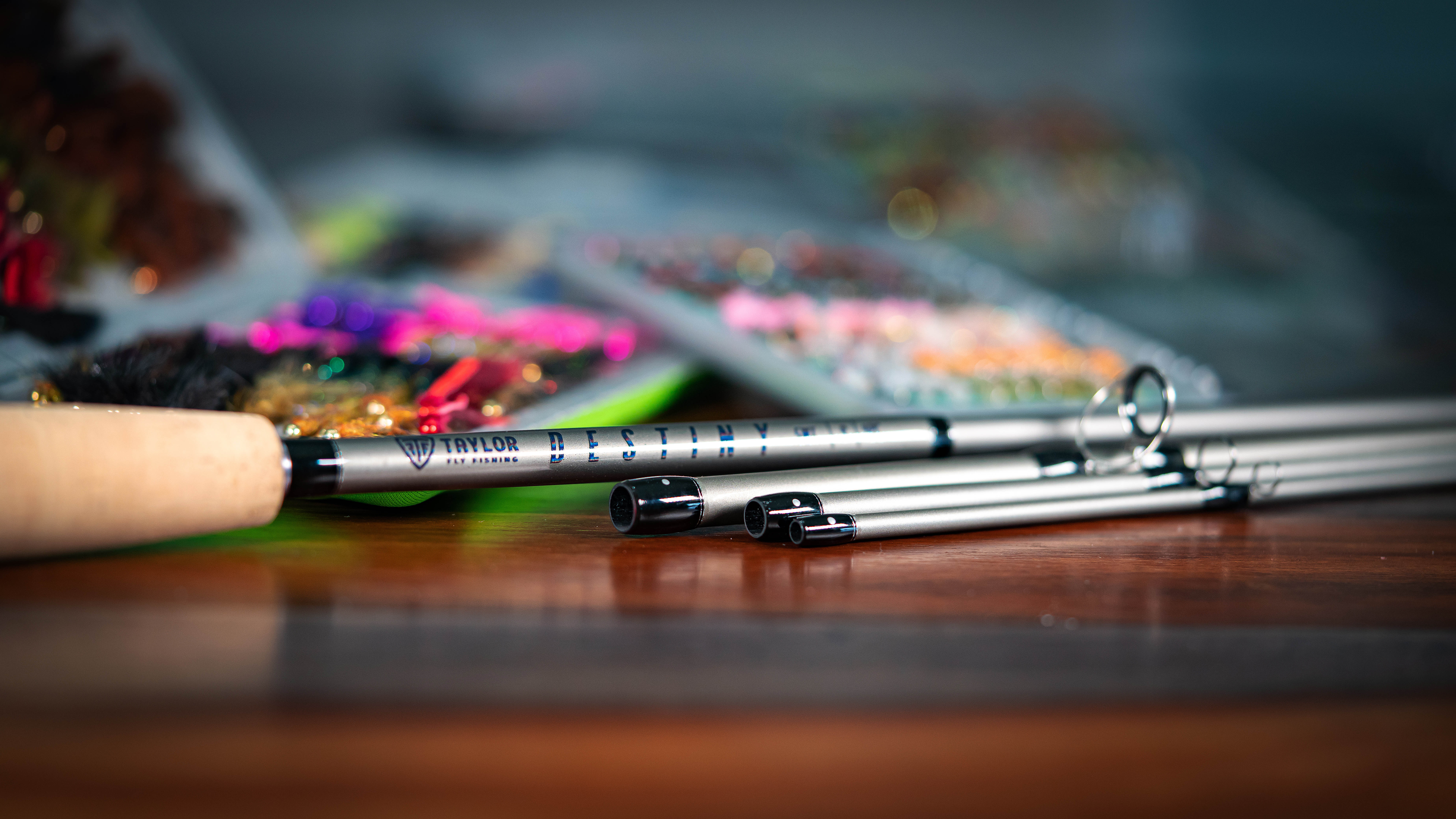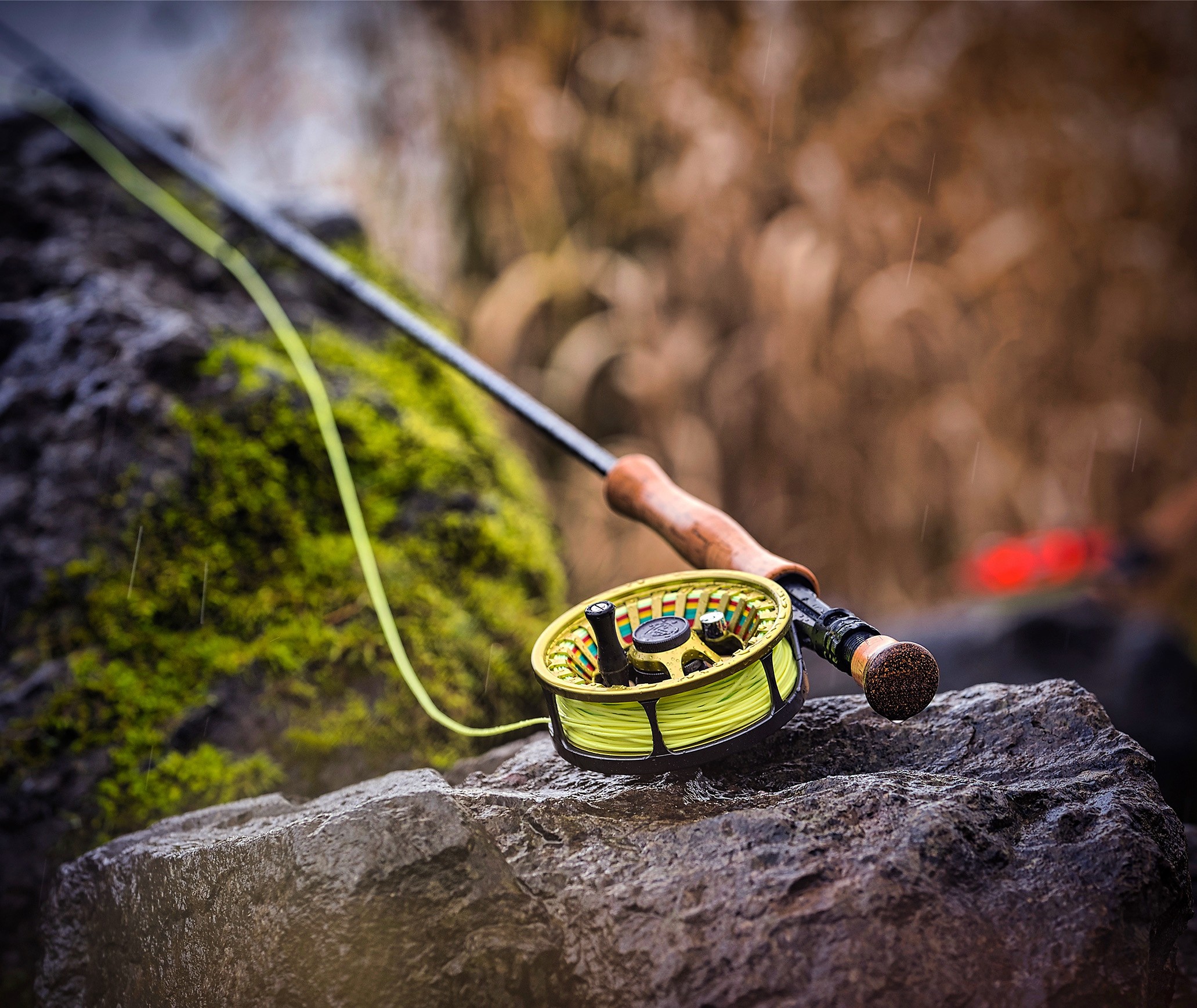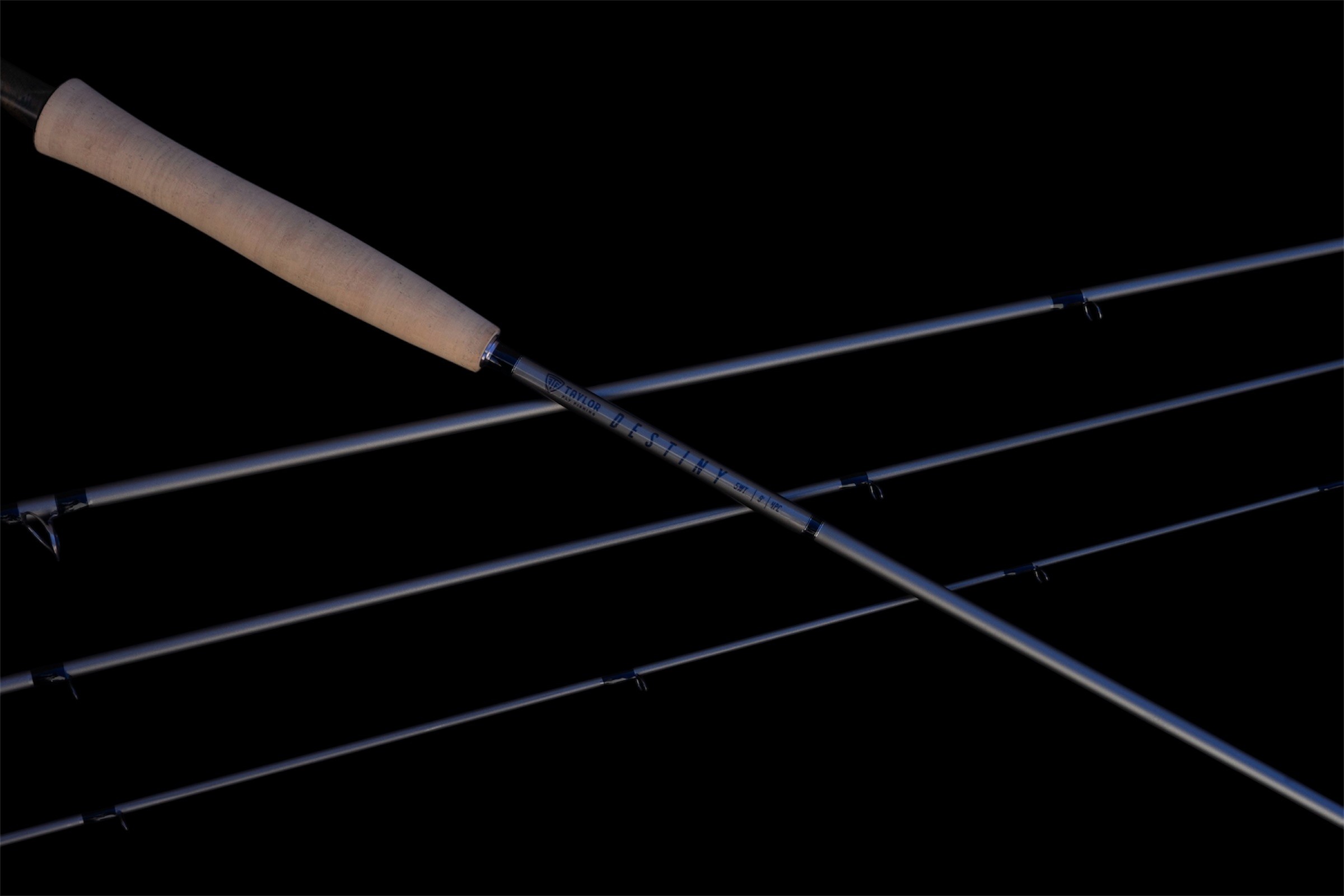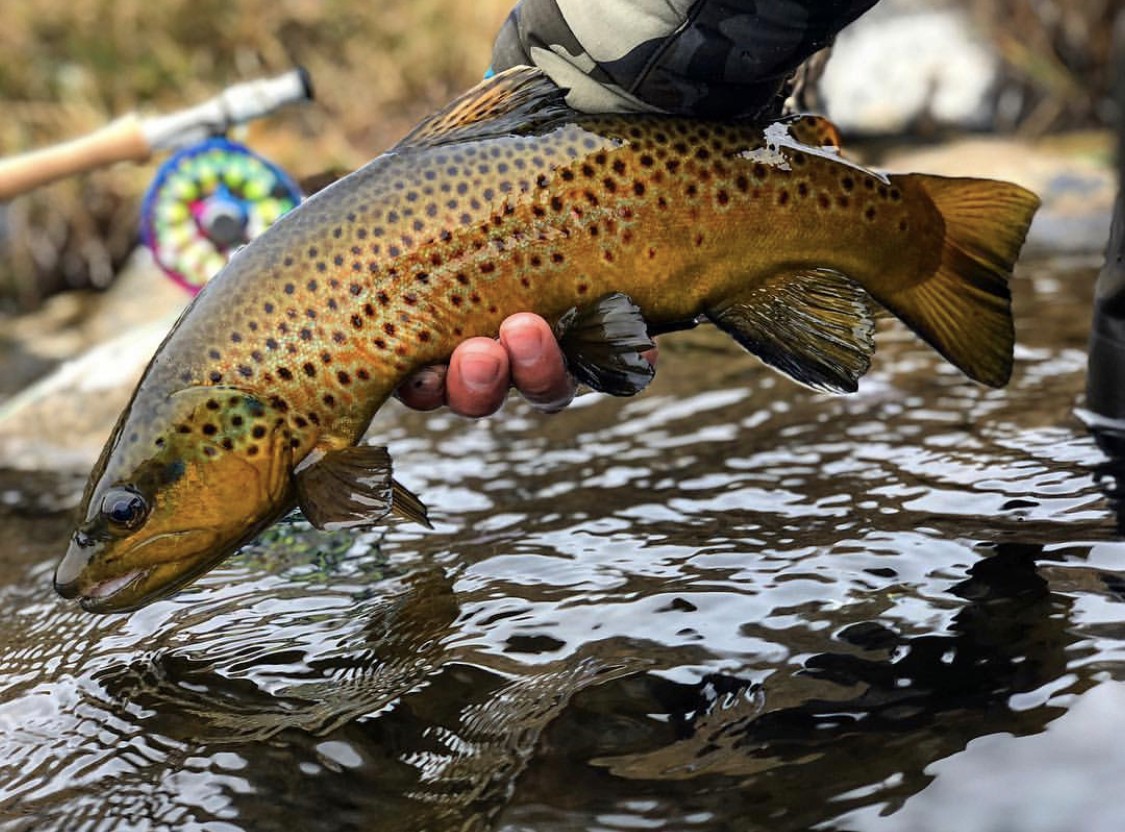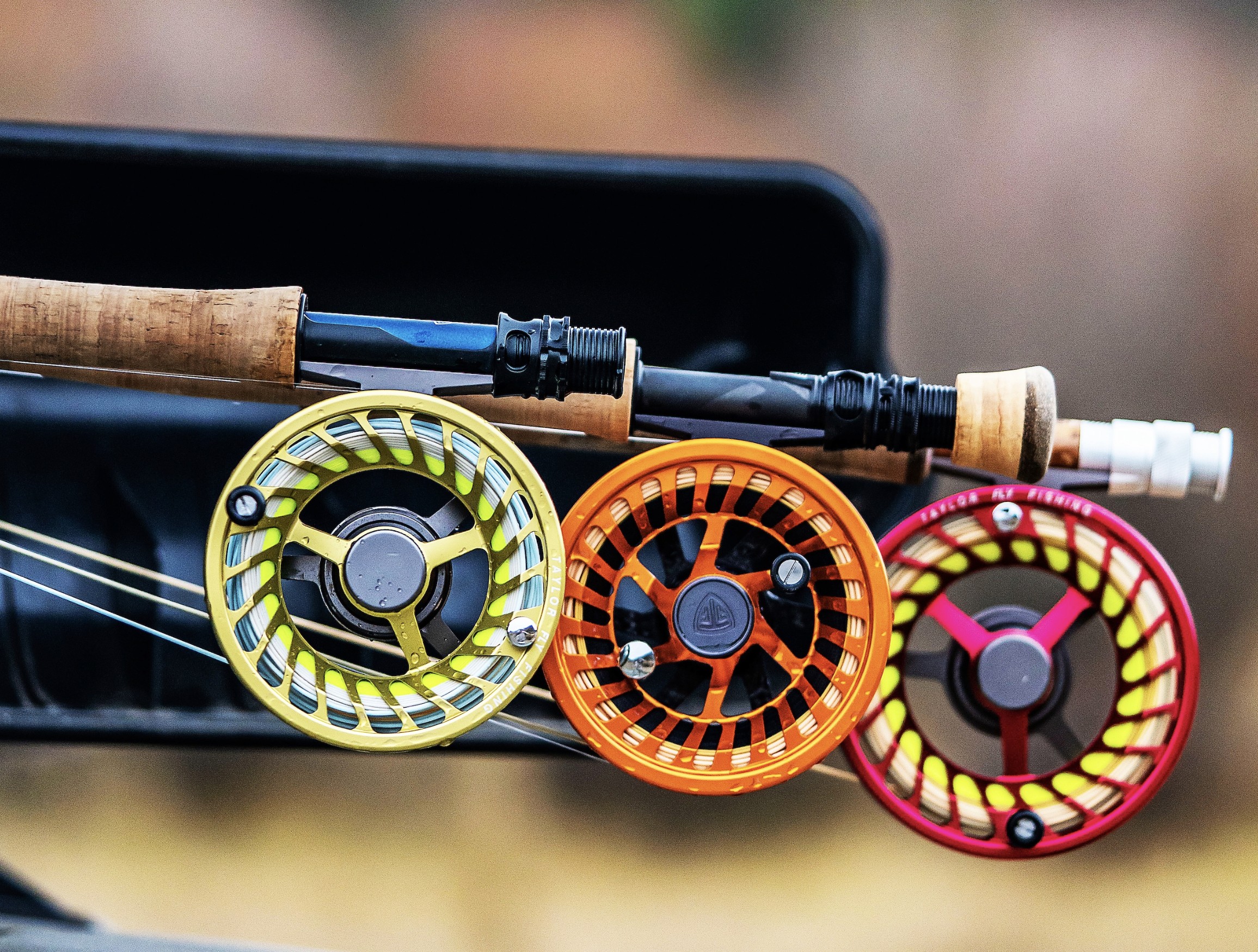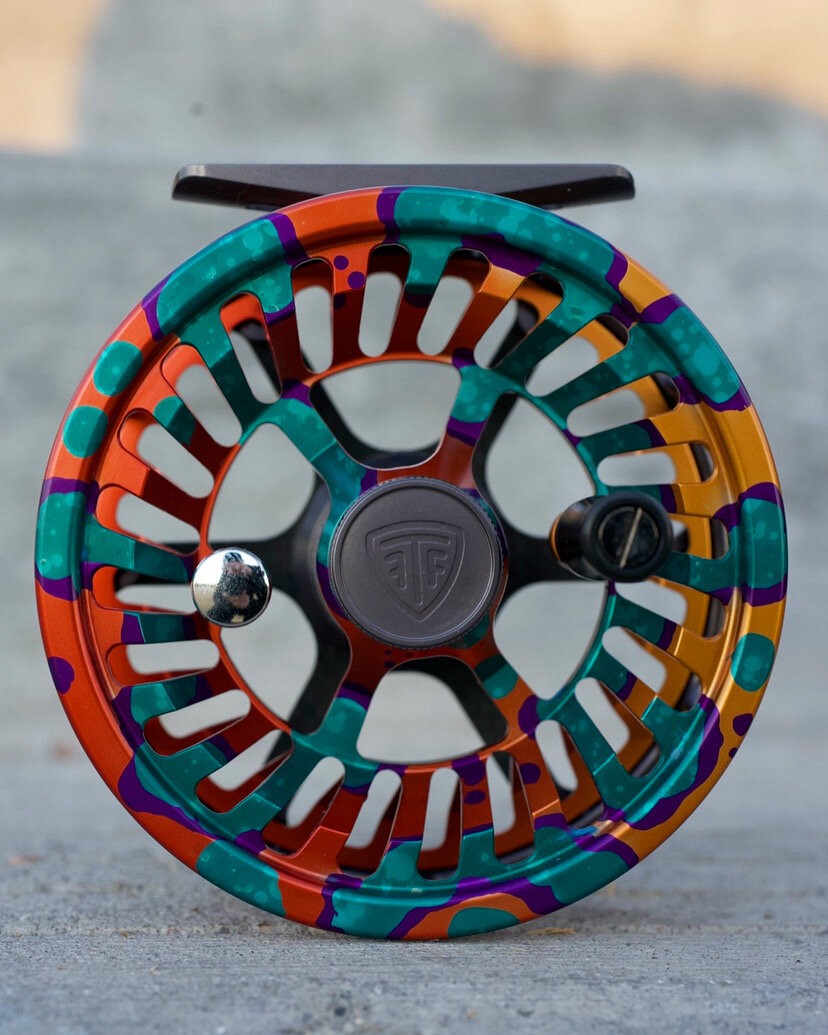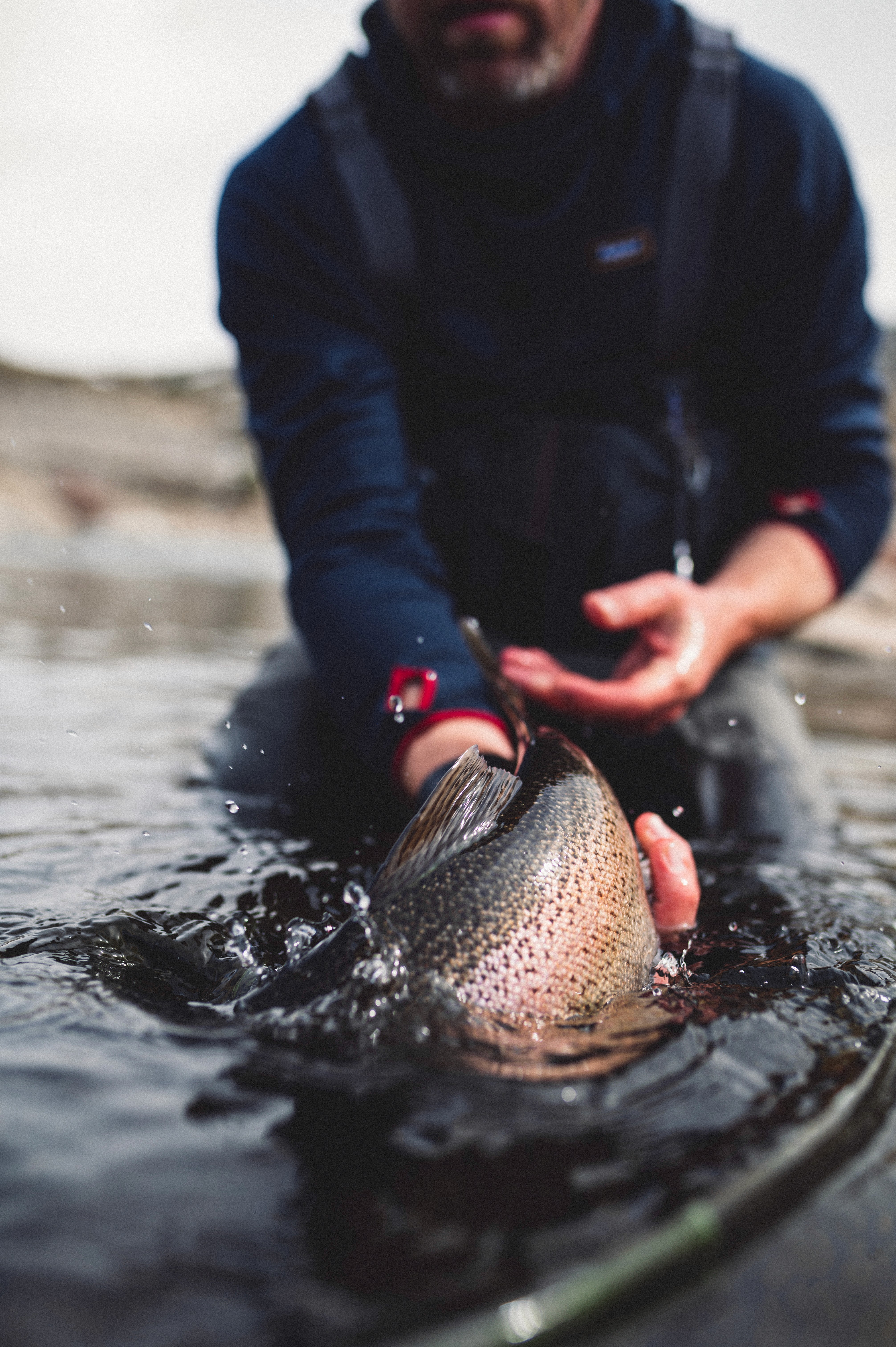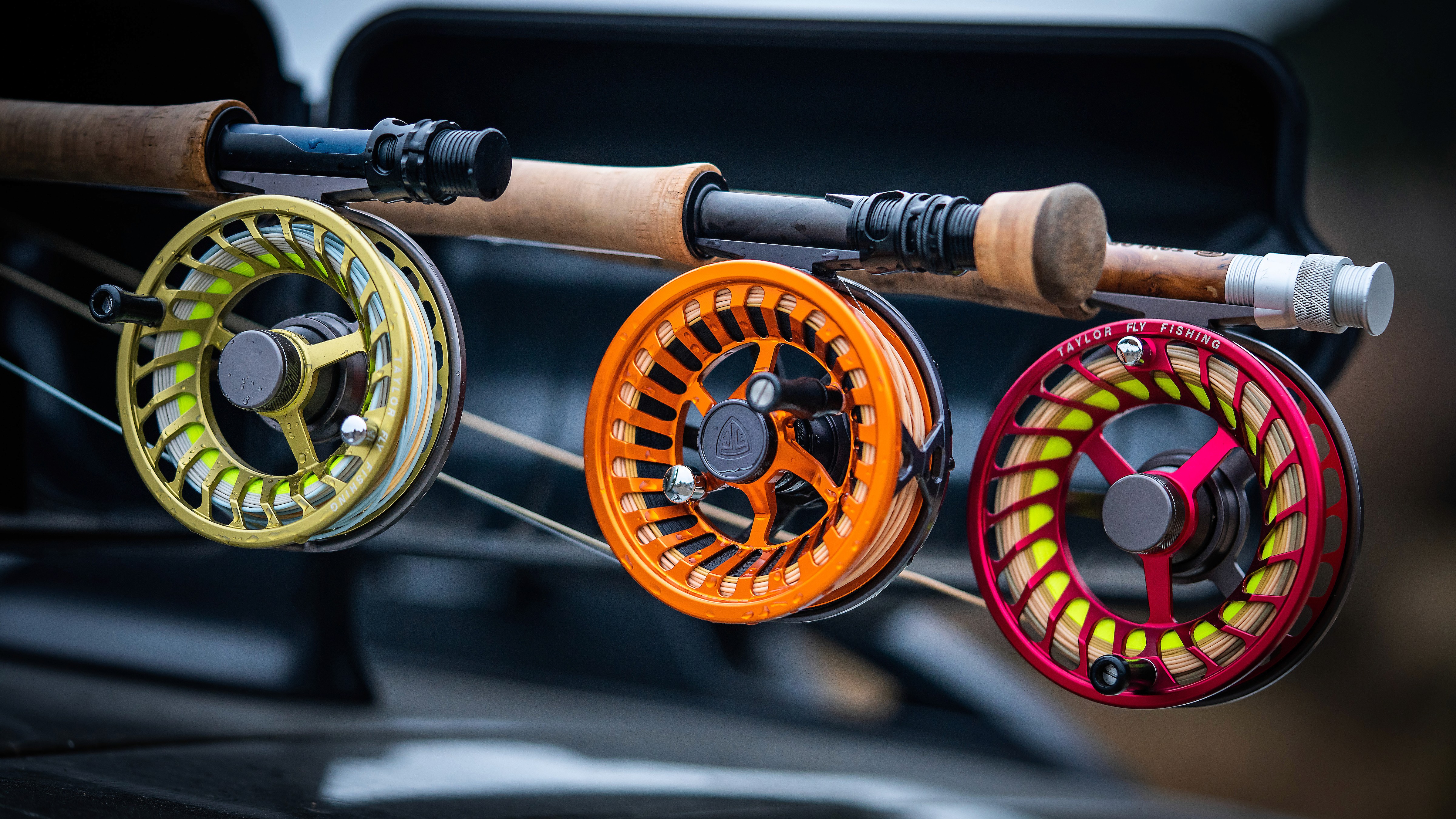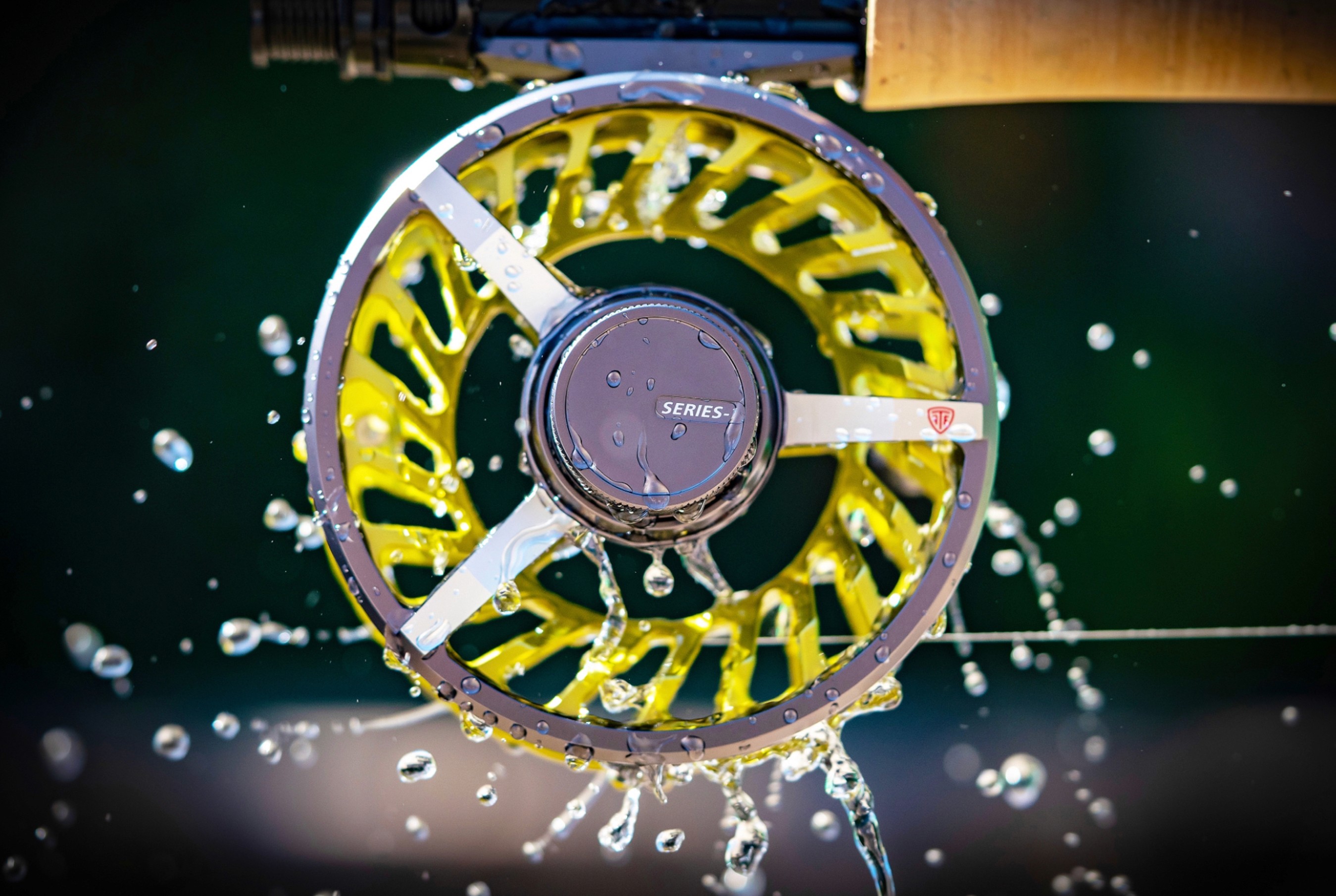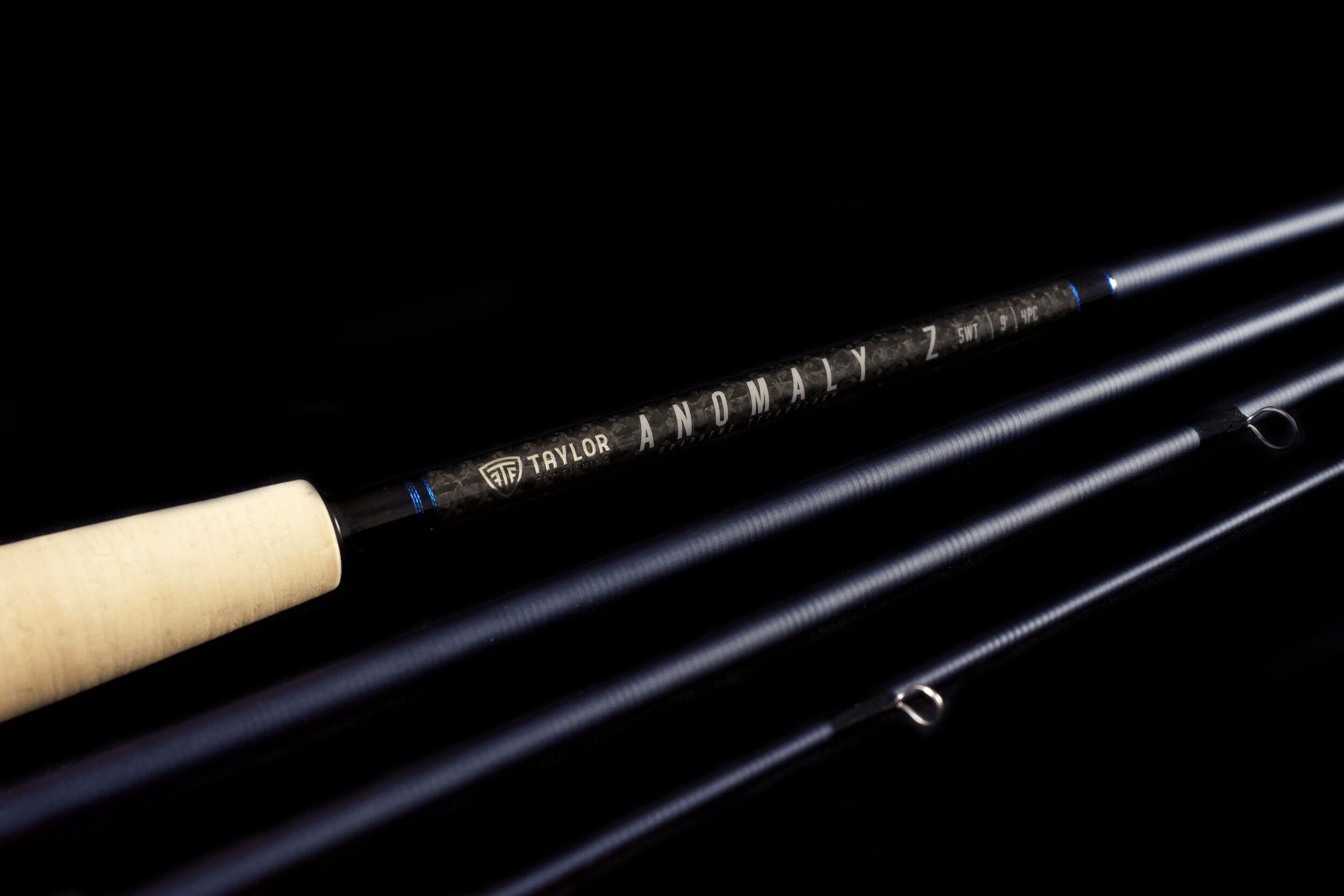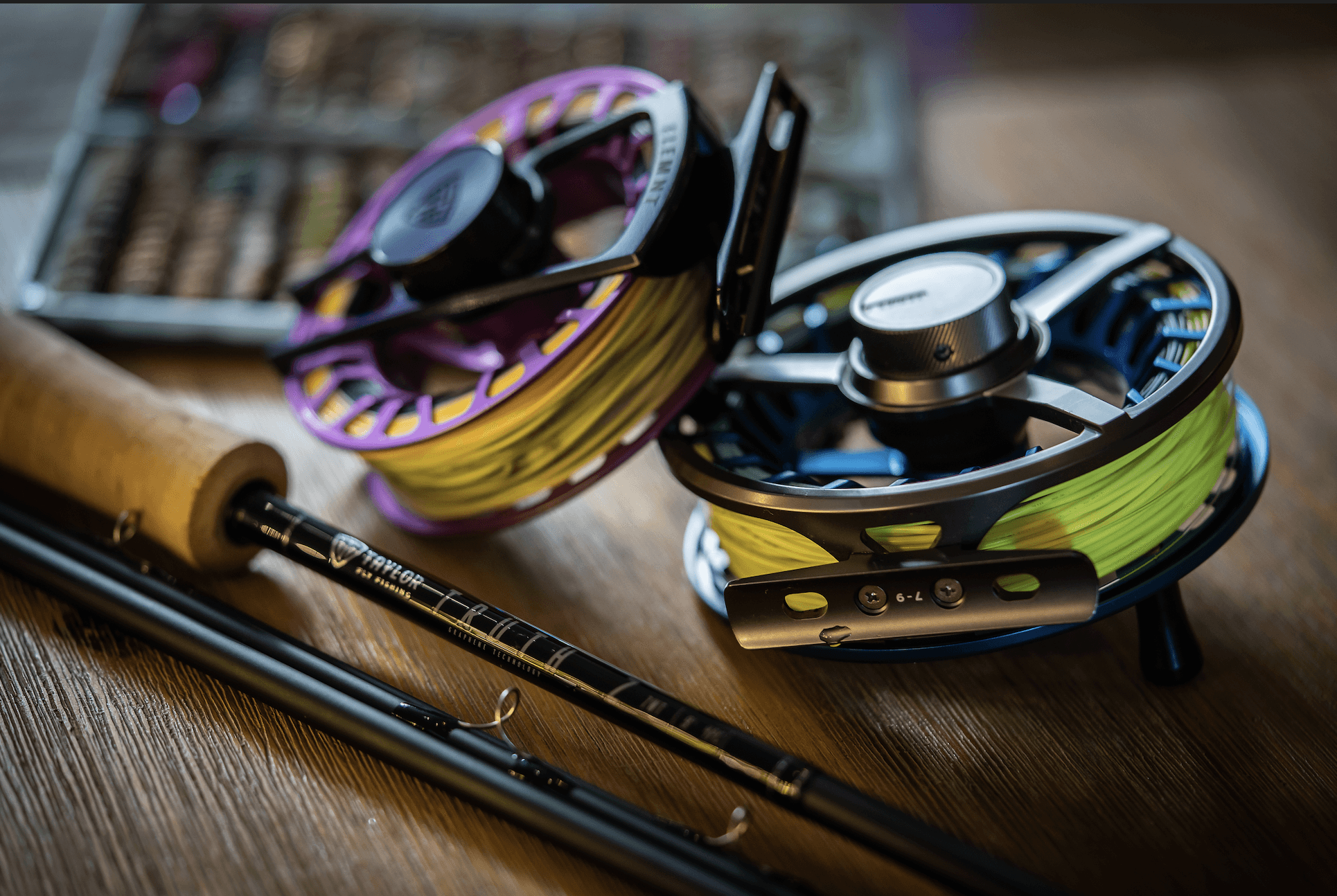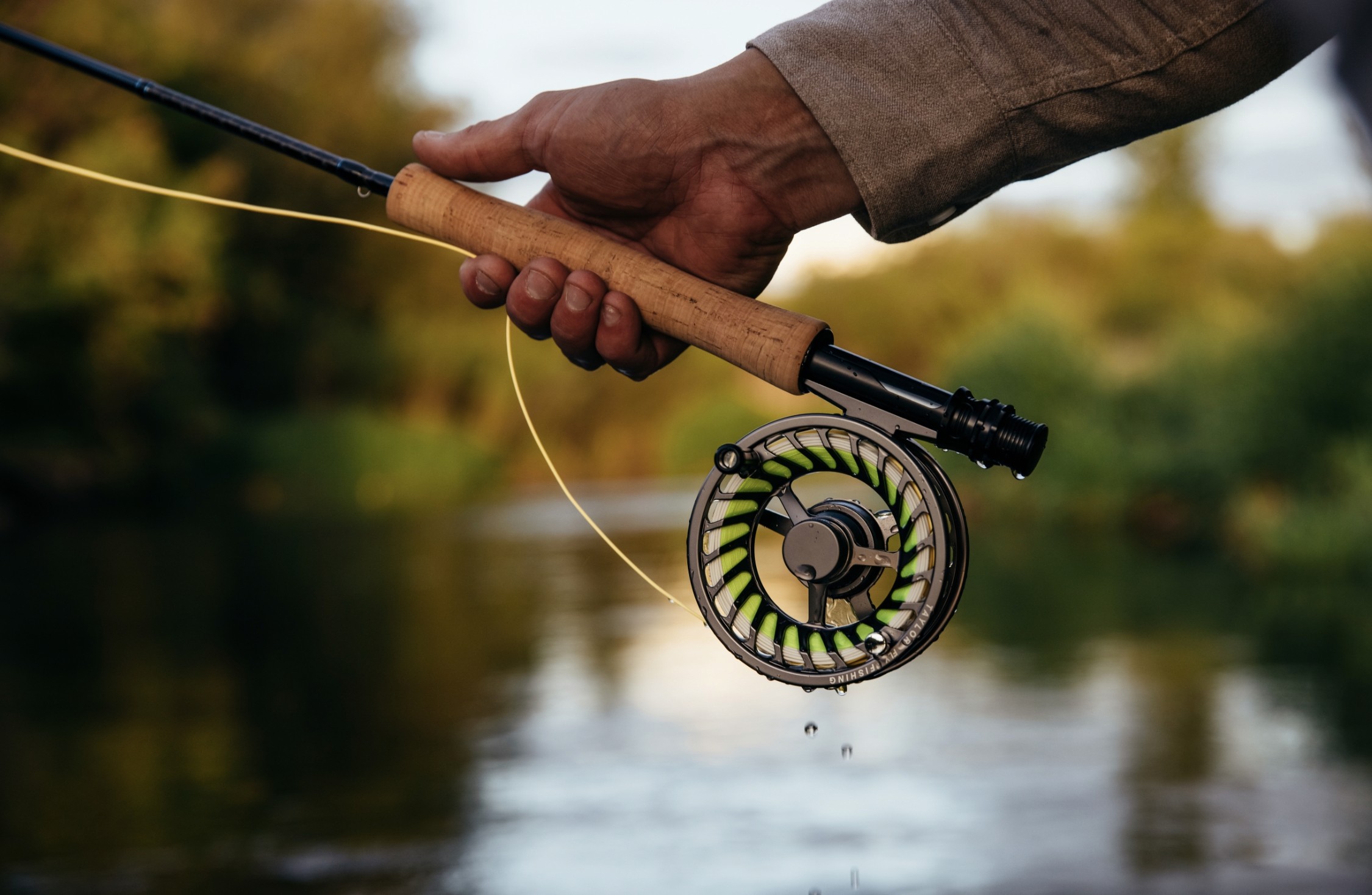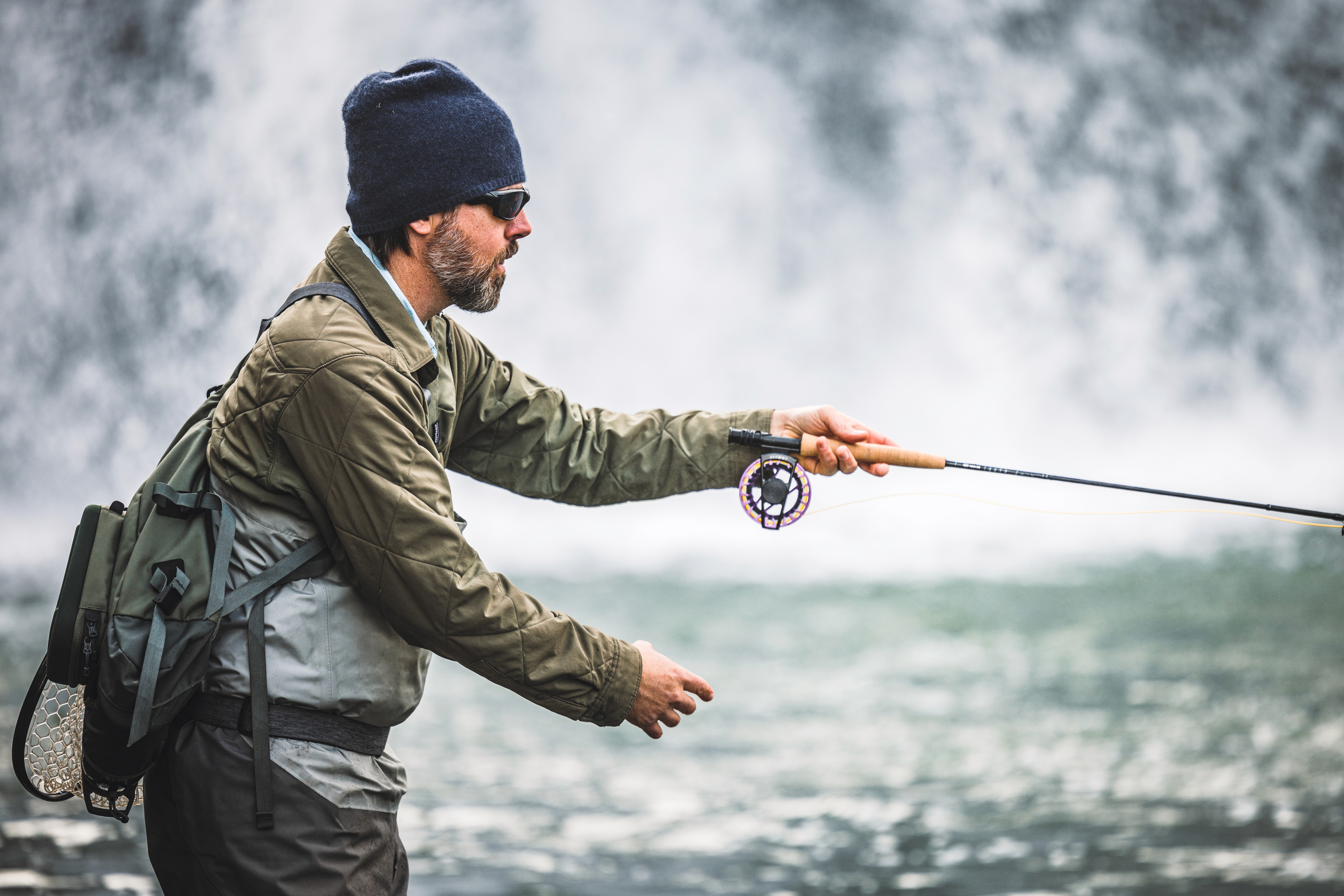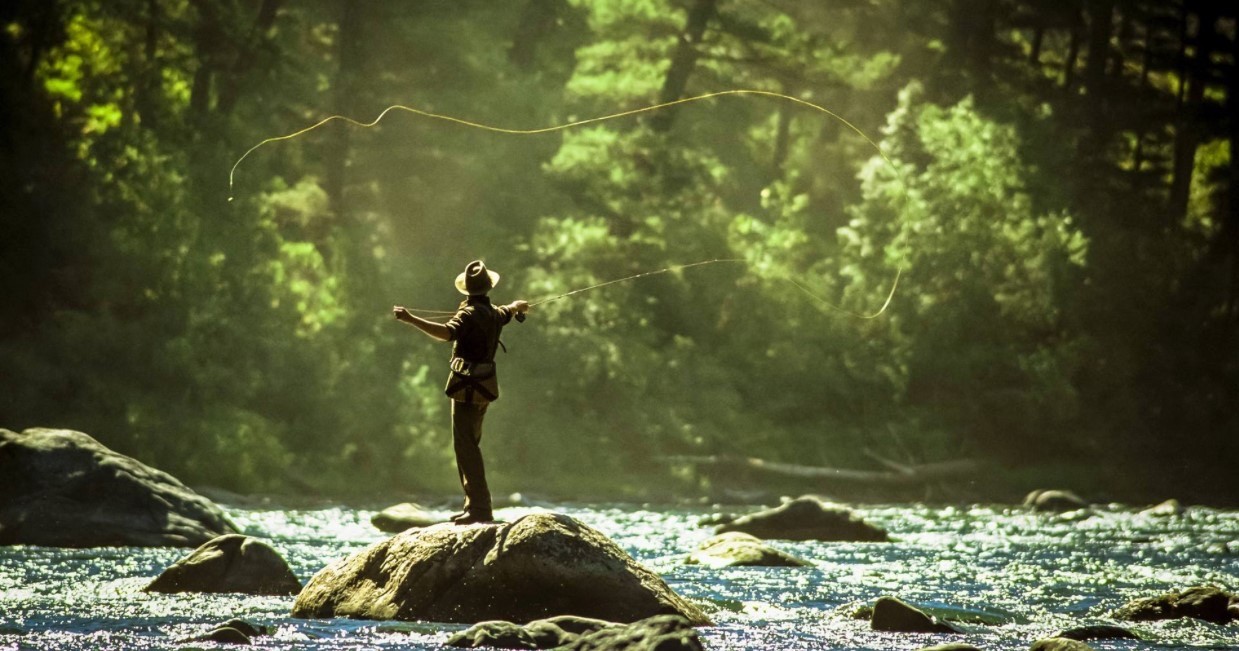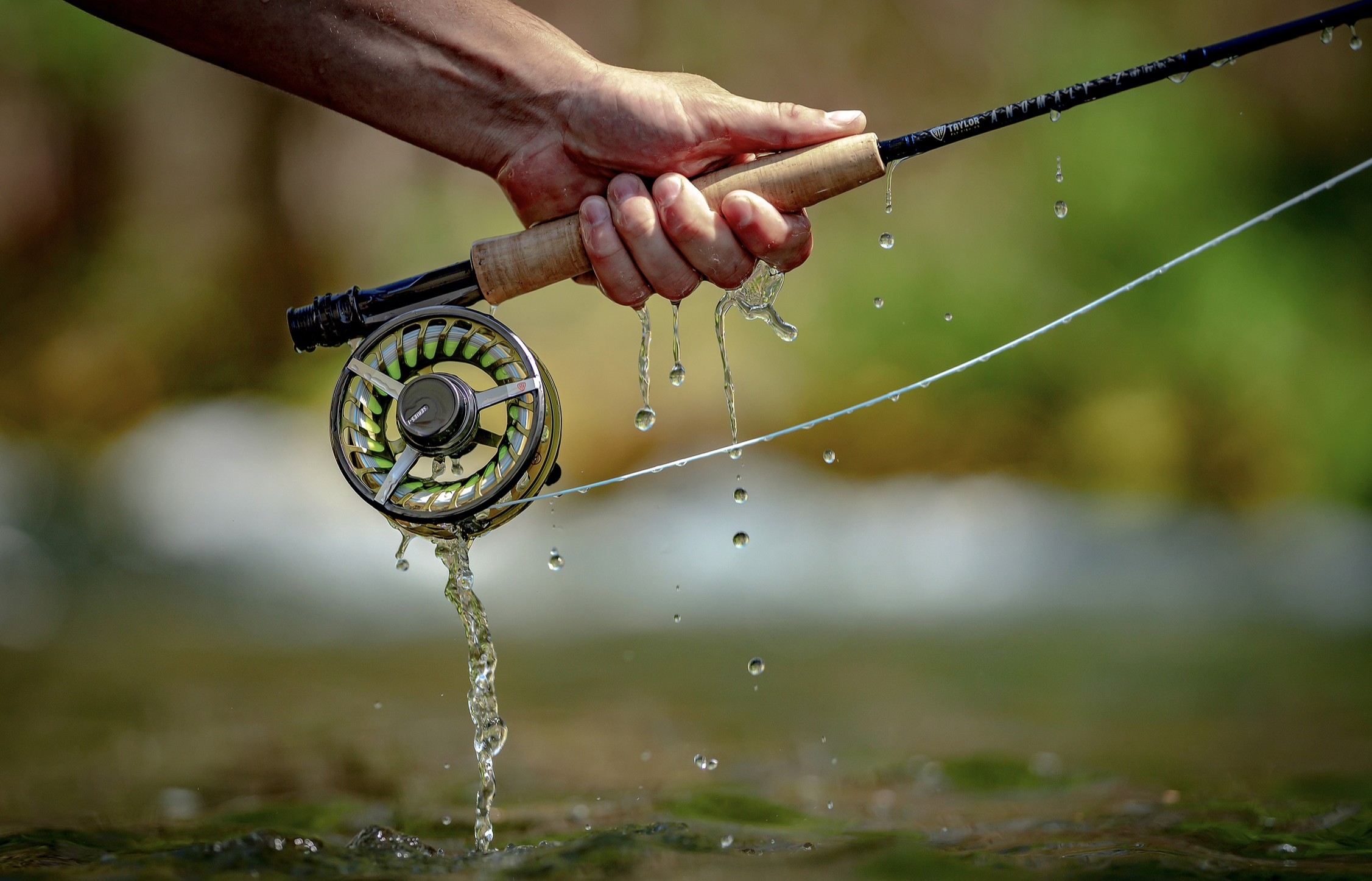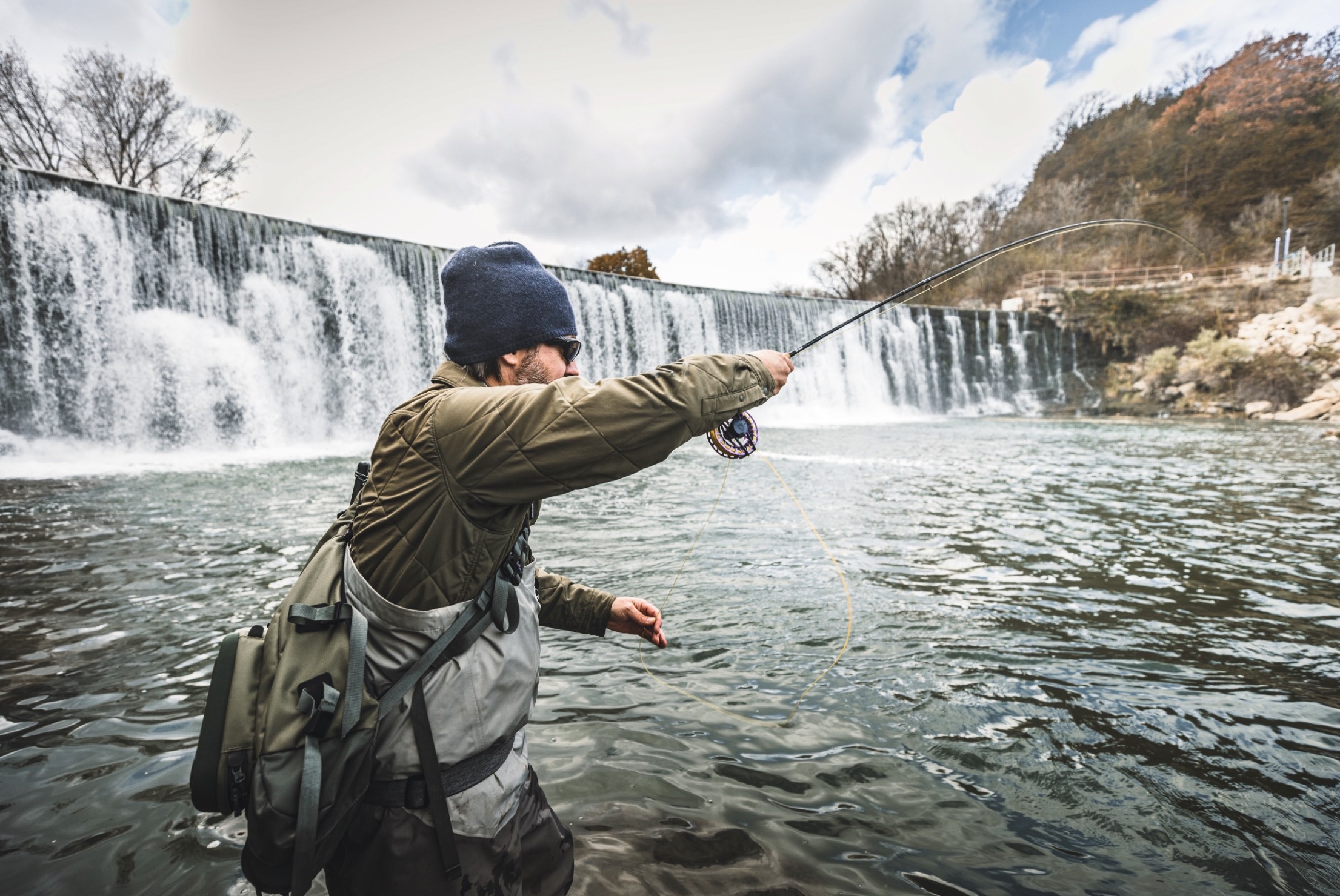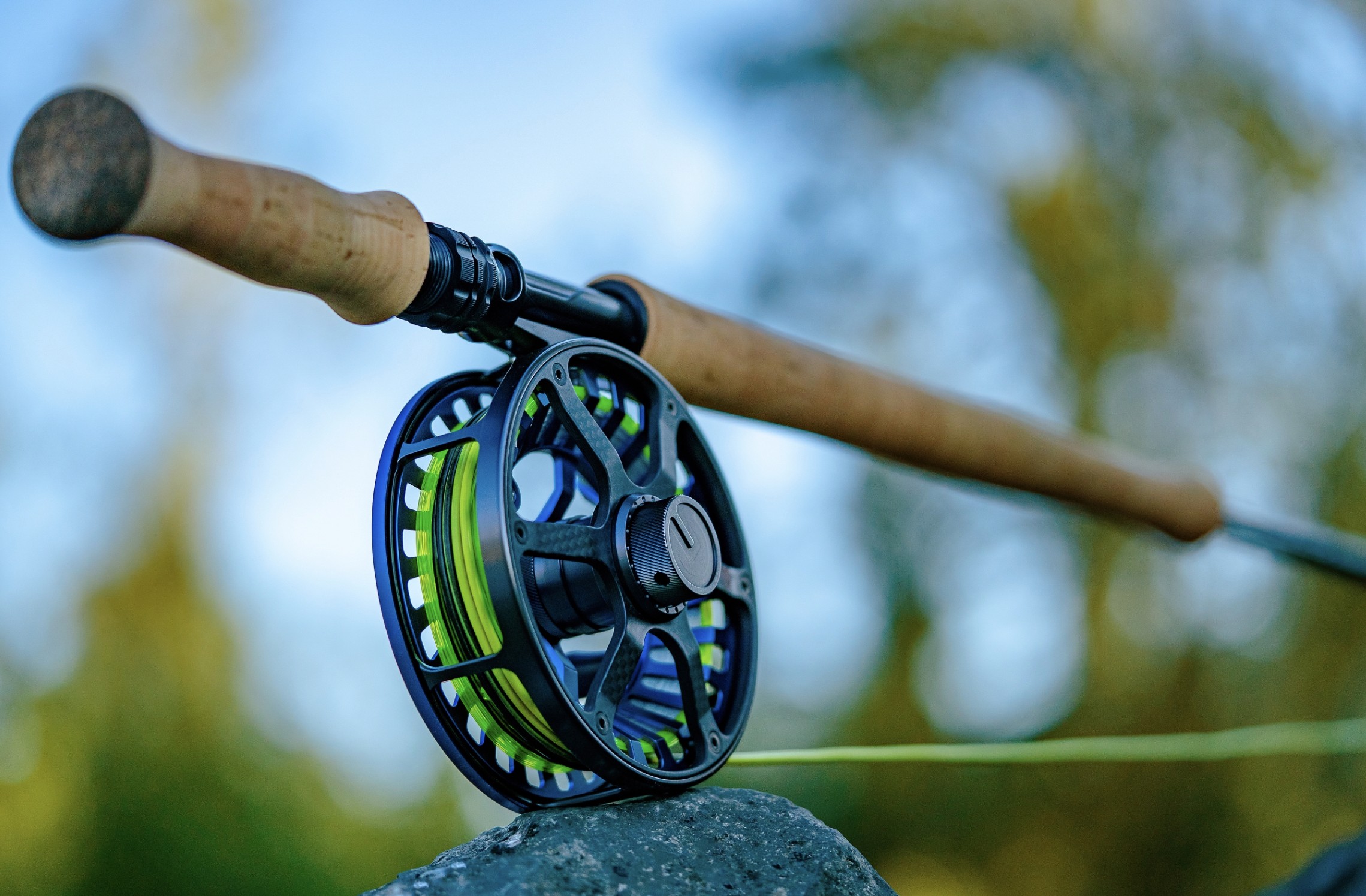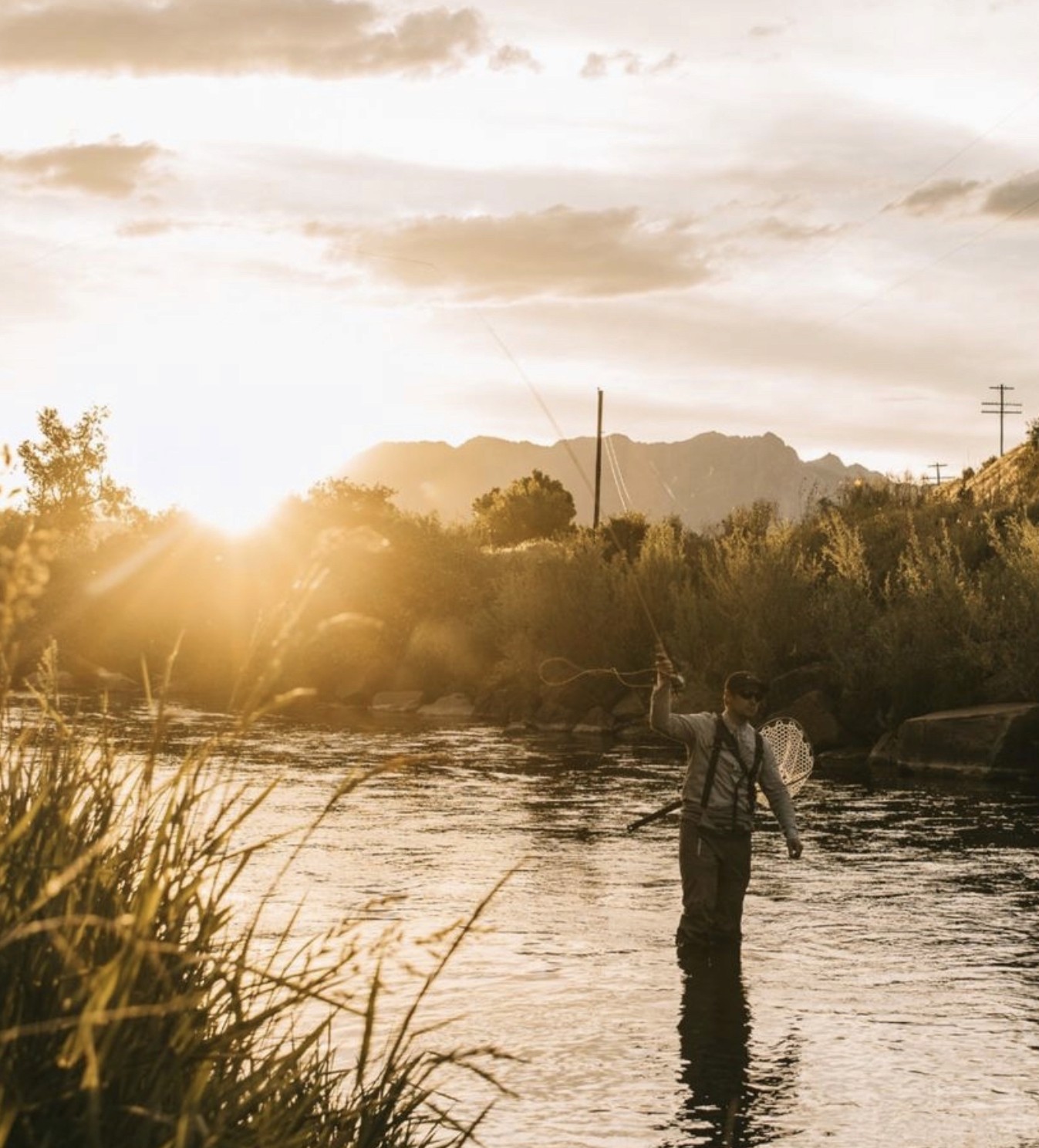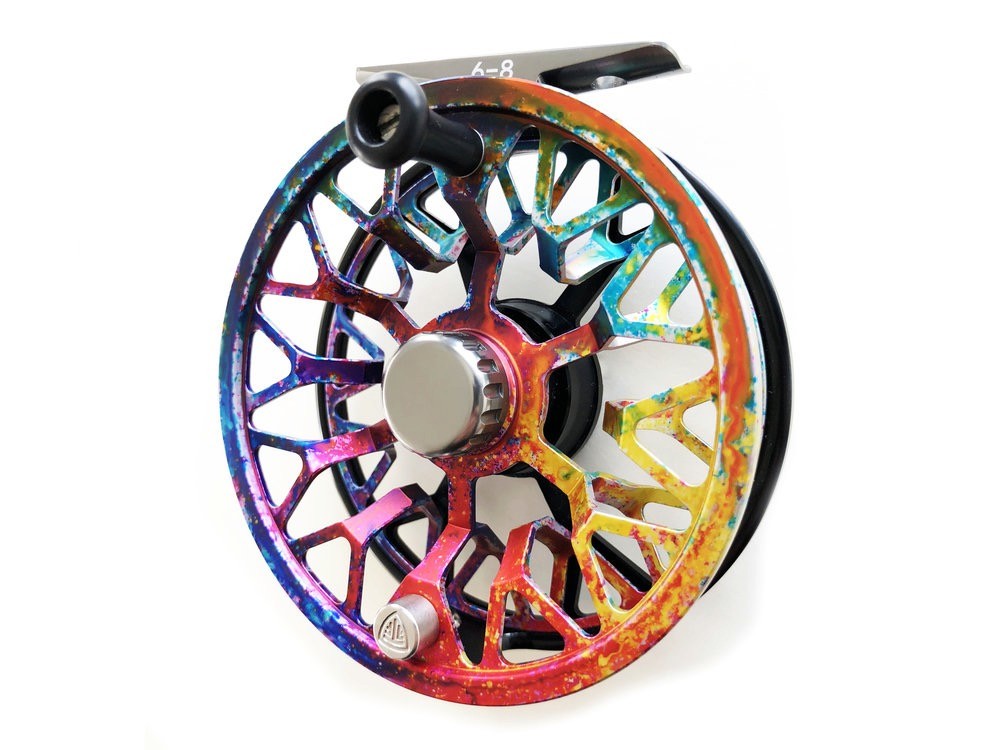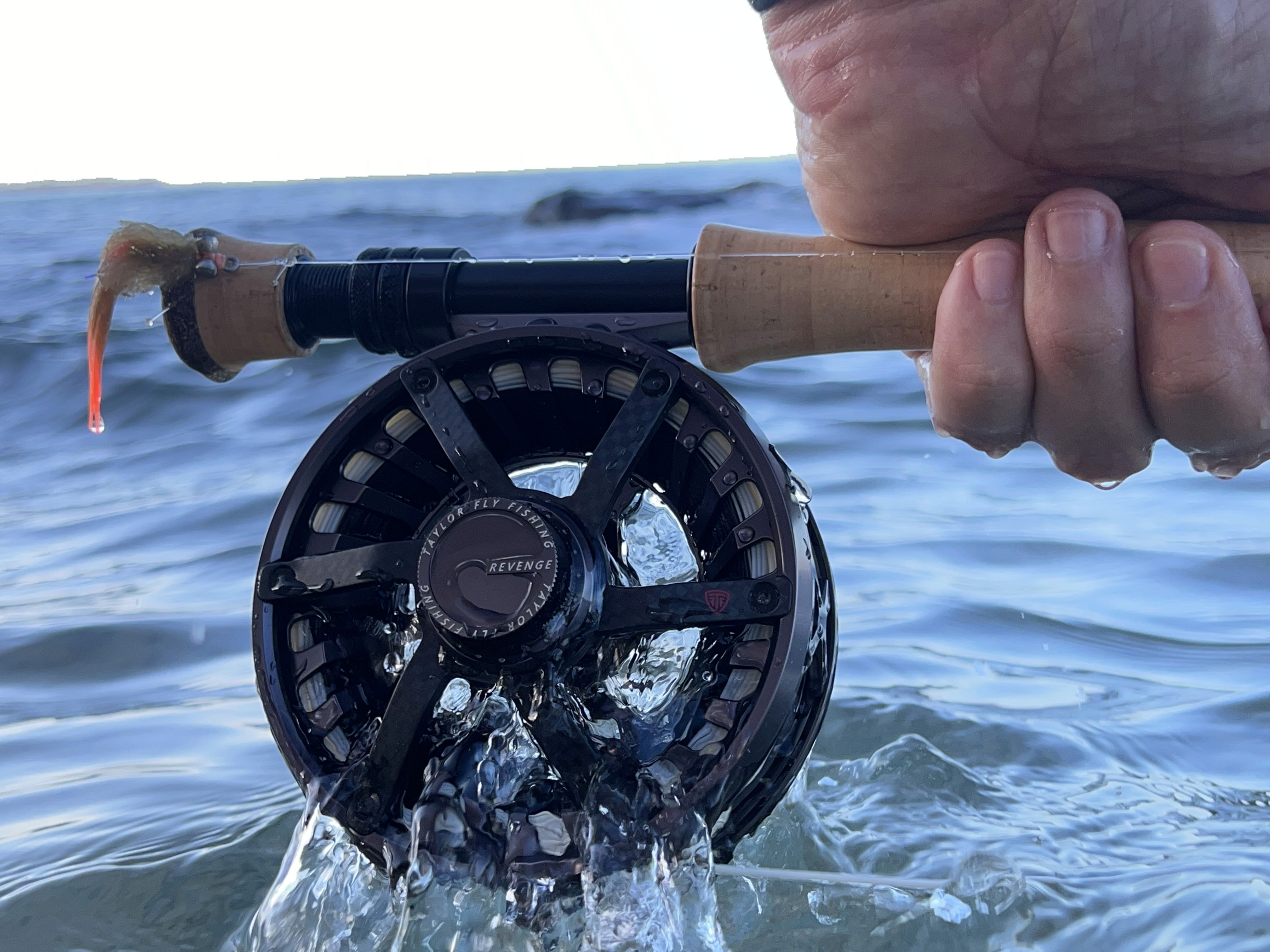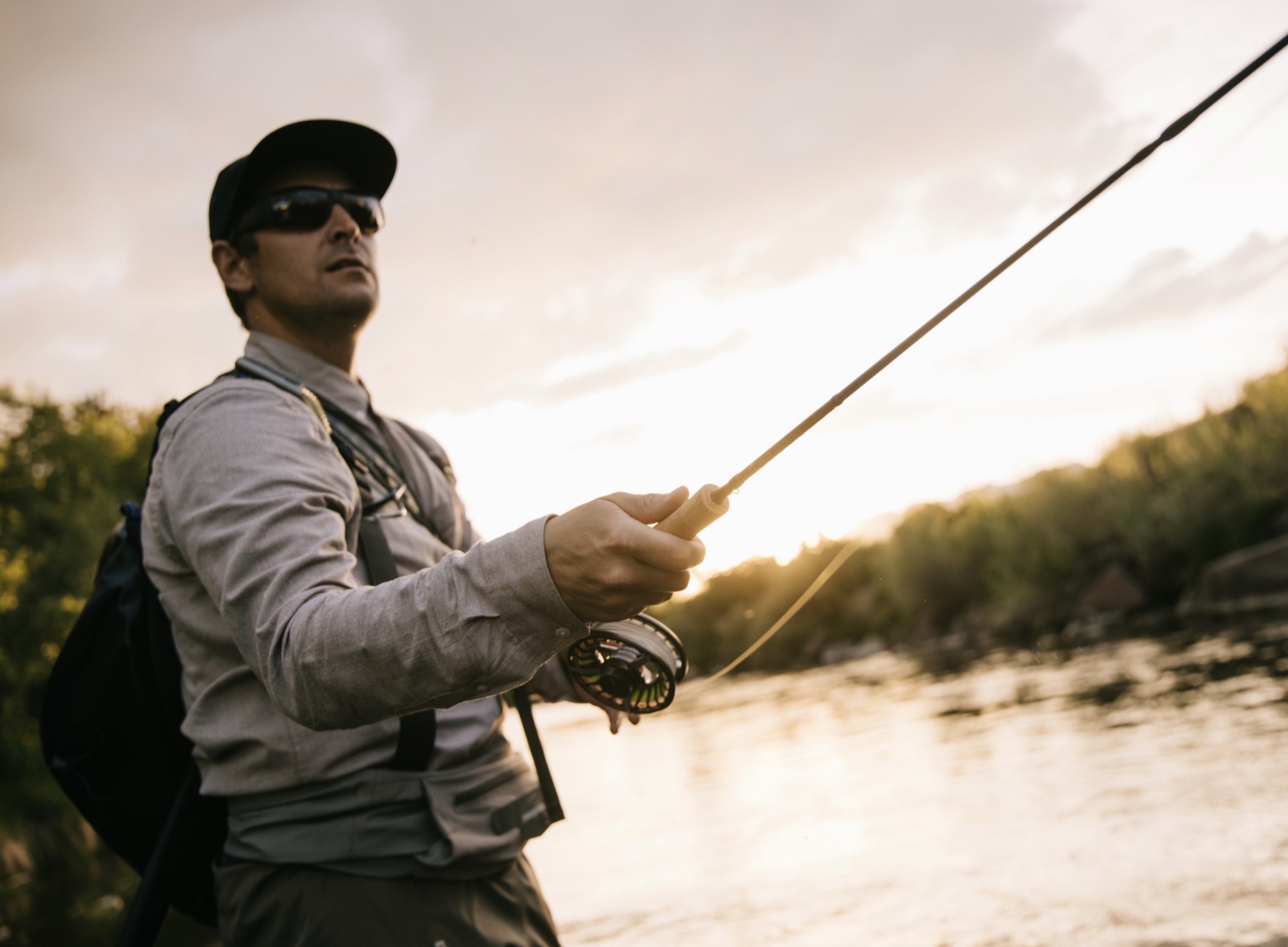Feb 18, 2025
The Three Key Elements of Fly Rod Design: Form, Function, and Feel
Have you ever heard the old adage, “Defense wins championships”? Most championship teams share common ingredients: a stout defense, superstar players in the right positions, and getting hot at the right time. This leads me to ask: what makes a championship-level fly rod? Not a rod that merely wins awards or competitions, but one that checks all the major boxes required to truly be great.
I believe that great fly rods share three key characteristics: Form, Function, and Feel. A well-designed rod is not only aesthetically pleasing but also performs its intended task efficiently and provides an intuitive and enjoyable casting experience. Let's break down these three crucial elements.
Form: The Marriage of Aesthetics and Craftsmanship
Form is both subjective and objective. While personal preferences may vary, some anglers prefer nickel hardware and a wooden reel seat, while others lean towards anodized aluminum and carbon fiber, certain aspects of rod design are universally recognized as signs of quality.
When evaluating a rod's form, consider:
Craftsmanship: High-quality cork, precise thread wraps, and smooth, even epoxy work indicate a well-made rod.
Materials: Premium rods should utilize top-tier components, such as lightweight and durable blank materials.
Guide Choice: Thick, heavy guides are outdated and often a sign of cost-cutting. Today’s premium rods should incorporate lightweight, high-performance guides that enhance both aesthetics and performance.
A great rod doesn’t just look good, it should reflect meticulous attention to detail and premium materials.
Function: Performance That Meets the Task
A fly rod is, above all, a tool. It must perform its job efficiently and effectively. Let's use a quality 9' 5wt rod as an example. A well-designed 5wt should be:
Accurate: The rod should deliver the fly where you intend without excessive effort or manipulation.
Balanced: Each section should work in harmony, avoiding hinge points that disrupt energy transfer.
Progressively Tapered: Power should originate from the butt section and transfer smoothly toward the tip, allowing for controlled and precise casts.
Fast Recovering: The blank should promote quick recovery without excessive vibration or wiggle, ensuring that the rod tracks straight and efficiently transmits energy from the caster to the fly line.
A rod’s function is a testament to its designer’s expertise. The best rods feel effortless, transferring energy smoothly and effectively to maximize control and accuracy.
Feel: The Extension of Your Arm
Some argue that “feel” is subjective, but I would challenge that notion. While action preference is personal, a great fly rod should feel like a natural extension of your arm.
Key elements of feel include:
Light Swing Weight: A well-balanced rod should not feel cumbersome. Excess mass in a rod is often mistaken for “feel,” but it actually slows down casting efficiency.
Optimized Energy Transfer: The best rods allow the caster to feel the line loading and unloading in the air rather than feeling the weight of the rod itself.
Quality Blank Materials: Advanced materials create a light, compliant blank that enhances sensitivity and responsiveness.
For less experienced casters, excess mass can serve as a crutch, signaling load and covering casting weaknesses. However, experienced anglers benefit from a rod that feels weightless in the hand while providing clear feedback through the line. This promotes higher line speed, better accuracy, and a more enjoyable casting experience.
Conclusion: The Perfect Balance
A championship-level fly rod is the result of achieving the perfect balance between form, function, and feel. A beautiful rod with poor performance is merely a showpiece. A functional rod that lacks refinement may be effective but uninspiring. And a rod with great feel but poor construction will ultimately disappoint.
When choosing your next fly rod, consider these three elements carefully. Seek a rod that not only looks great but also performs seamlessly and feels like an effortless extension of your casting stroke. The best fly rods are those that disappear in your hand, allowing you to focus entirely on the water, the cast, and the fish at the other end of the line.
At the end of the day, a truly great fly rod is one that enhances your experience on the water, a tool that works in harmony with your skills, elevating every cast into something greater than just a simple motion. That’s what makes a championship-level fly rod.
Tight Lines,
Matthew
Jan 31, 2025
Common Mistakes New (and Experienced) Fly Fishermen Make
Going Past 90° When Landing a Fish
So, you hook into the fish of a lifetime but are fishing solo and have to land it without assistance. Many of us have been in this situation. Landing a fish solo can be challenging. One critical mistake fly anglers make is over-bending the rod past 90 degrees, risking a rod break. Often, rods broken this way will snap near the tip or second section. The easy solution is to reel in as much line as possible and pull the rod away from the net while keeping the rod below 90 degrees when landing the fish.
Not Breaking Down Your Rod When Traveling
Here's another easy way to break a rod. We've all been guilty of it. I've broken a rod just by tossing it in the bed of a truck for a quick drive back to camp—rookie mistake! I know breaking down your rod isn't always convenient, but it will save you from an expensive break.
Stripping Line Off the Reel While Rubbing the Frame
This is a mistake even seasoned anglers make. When stripping line off the reel, first make sure the drag isn't set too heavy. Second, always strip toward the tip of the rod—not down or back. Stripping against the frame risks damaging your fly line and can even wear through the anodizing and aluminum of the reel over time. You’d be surprised how much damage a fly line can do when stripped incorrectly.
Wet Fly Boxes and Rusted Hooks
I’ve ruined entire fly boxes by storing them while wet, resulting in rusty hooks. Rusty hooks break, making the flies useless. If your fly box gets wet inside, make sure to leave it open to dry out before storing it. This simple step can save you from a frustrating day of broken hooks and lost fish.
Not Learning to Double Haul
I’ve found time and time again that saltwater fly anglers are better casters than their freshwater counterparts. The reason? In saltwater, you must be able to double haul, cast into the wind, and consistently hit at least 40–50 feet. You might get away with sloppy casting on your local small stream, but if you ever travel to a saltwater destination, you better practice that double haul!
Changing Flies Before Adjusting Weight
Trout are opportunistic predators. They want fast, easy, and energy-rich food. Too often, I see anglers constantly changing flies on a slow day without adjusting their weight. My first thought when fish aren’t eating is: Am I getting deep enough, fast enough? If my fly isn’t getting in front of that picky trout, it probably won’t move up in the water column to eat. I change flies when needed, but I always think weight first.
Not Learning to Read the Water
I’ve been on the river countless times watching a helpless angler skip over a prime piece of fishy water to head straight for the big pool up ahead—simply because they don’t know how to read the water. When I look at a river, I can see where the fish want to hold—along the side, behind a boulder, in the riffles, or under the foam lines. Learning to read the water will give you more opportunities to catch fish.
Sitting in One Hole All Day
When I fish, I like to cover a lot of water. I grew up on streams that required you to move, walk, and search for fish. Covering more water in a day increases your chances of finding more fish—and bigger fish. I’ve done ten-mile backcountry days chasing trout. I know you saw that one fish in that one hole, but let him be and move on to new water.
Are there any other mistakes you can think of? Let us know by leaving a comment!
Tight Lines,
Matthew Taylor
Jan 6, 2025
Learn about the Destiny fly rod from Taylor
I started Taylor Fly Fishing a few years after college. I was newly married, and premium fly fishing gear was not in the budget. My primary passion in starting the company was to provide maximum value in our products by offering affordable prices without sacrificing quality. While all our products reflect that vision, our newest creation, Destiny, perfectly aligns with everything Taylor Fly Fishing stands for.
Our latest rod offering is called Destiny because it feels like the rod we were always destined to design. Destiny is a mid-priced rod. What you get for $450 cannot be matched. In the fly rod market, mid-priced options often come with compromises in design, materials, craftsmanship, and overall quality. Many manufacturers intentionally limit their mid-priced rods to avoid competing with their premium lines. But with Destiny, we refused to compromise.
Let’s dive into the technology, design, and details that make Destiny exceptional.
HYBRID DESIGN
The Destiny rod uses the same Graphene carbon scrim found in our Anomaly Z, Truth Z, and Refine Z series. The top two sections of the rod—where most of the perceived swing weight is concentrated—feature graphene-infused carbon. Meanwhile, the lower two sections utilize our previous-generation nanosilica carbon. This hybrid design provides the lightweight feel of our premium Z-series rods without the added cost of a fully graphene build.
The result? The 5wt Destiny has a physical weight of just 2.65 ounces and a perceived swing weight remarkably close to the feather-light sensation of our Z-series rods. I would argue that Destiny is not only the best mid-priced rod on the market but superior to most premium rods out there.
TAPER DESIGN
The taper of the Destiny is based on the Truth Z and Anomaly Z models. Its action sits between the two, placing it on the upper end of medium-fast. The rod delivers an incredibly smooth and powerful performance without feeling stiff or challenging to time your cast. It’s the perfect blend of power and finesse, making it versatile for various fishing scenarios.
CORK
No mid-priced rod has ever featured premium cork—until now. Destiny uses the same top-quality cork as our Z-series rods. We made no sacrifices here, ensuring you get the same comfortable, high-end feel typically reserved for premium rods.
CRAFTSMANSHIP AND COMPONENTS
Taylor Fly Rods are known for industry-leading craftsmanship, and Destiny is no exception. Our signature smooth and flawless epoxy work is a hallmark of this rod.
The Destiny is equipped with simple yet reliable light-wire chrome guides. The blank features a matte dark gray finish with shimmering iridescent branding in dark pearl. A burl wood insert and an indexed reel seat complete the build, giving the rod a clean, modern, and attractive design.
PRICE
At $450, Destiny is positioned at the lower end of the mid-priced range for fly rods. However, the quality and performance you get at this price point are unparalleled. There is truly nothing on the market that compares. This is the rod we were destined to create, and we believe it’s the rod you were destined to fish.
LIMITED PRE-ORDER OFFER
Destiny will be available for pre-order starting January 17th. For one hour only, from 6 PM MT to 7 PM MT, you can secure your Destiny rod at 20% off. Orders will be taken directly on our website, so mark your calendar and set your alarms!
Thank you for supporting Taylor Fly Fishing and for being part of our journey. We believe Destiny is more than just a rod—it’s the culmination of years of passion, innovation, and dedication.
Tight Lines,
Matthew Taylor
Dec 25, 2024
Conservation through buying a fly fishing rod or reel
One of the greatest privileges we enjoy in the United States is our unparalleled access to public lands and the outdoors. I love knowing that when I go fishing in the mountains, the land and rivers I’m casting into belong to all of us as Americans. Having had the privilege of fly fishing around the world, I can confidently say that this level of access is rare.
In many countries, fishing is limited to “beat fishing,” where you pay to access a small section of river for the day. While I don’t mind paying for premium fishing experiences occasionally, there’s something uniquely special about the free access we enjoy in the U.S., whether it’s for fishing, hunting, hiking, or simply soaking in nature.
The Pittman-Robertson Wildlife Restoration Act: A Legacy of Conservation
One of the reasons we have such incredible access to natural resources in the U.S. is the Pittman-Robertson Wildlife Restoration Act of 1937 and the Dingell-Johnson Funding Allocation of 1950. These landmark legislations place a small excise tax, around 10%, on all hunting and fishing supplies sold by U.S.-based companies. This tax directly funds wildlife conservation projects and public land access initiatives.
Every time you purchase a fly fishing rod or reel from a U.S.-based company, a portion of that sale contributes to maintaining and restoring the very lands and waters we cherish. From cutthroat trout restoration projects to the reintroduction of elk in states like New Mexico, the impact of this funding is monumental. Decades ago, elk were nearly extinct in parts of the West and completely eradicated in the East. Today, their haunting calls echo once more through these lands, all thanks to conservation efforts funded by Pittman-Robertson dollars. Cutthroat Trout were nearly wiped out in the Rocky Mountains, but today more and more restocking programs are expanding the cutthroat trout back into their traditional range thanks to these conservation dollars.
The Hidden Cost of Overseas Gear
The title of this blog, "Stop Buying Cheap Overseas Fly Fishing Gear," might seem provocative, but it’s rooted in a simple truth: every purchase of cheap, direct-from-China products through platforms like Amazon, Temu, or eBay takes valuable resources away from conservation.
This isn’t about the origin of the product or even its price. It’s about preserving the mountains, rivers, and valleys we love for future generations. Outdoor gear purchased from overseas vendors bypasses the Pittman-Robertson tax, depriving conservation efforts of millions of dollars annually.
If cost is a concern, I encourage you to find affordable alternatives from U.S.-based companies. Many offer budget-friendly options that still contribute to the greater good. All USA based companies pay into the Pittman-Robertson Wildlife Restoration Act regardless of where their products are made. Again, the products DO NOT need to be made in the USA as long as the company is based in the USA or has a headquarters here.
Invest in the Outdoors You Love
Imagine walking into the woods to fish a stream teeming with trout, hearing the bugle of an elk in the crisp autumn air, or simply marveling at the natural beauty around you. These experiences aren’t guaranteed, they’re the result of intentional conservation efforts funded by generations of outdoor enthusiasts who cared enough to give back.
When you choose to support U.S.-based outdoor brands, you’re not just buying gear, you’re investing in the future of our public lands and wildlife.
Here is a chart of how the Pittman-Robertson funds are distributed across states.
Tight Lines,
Matthew Taylor

Dec 22, 2024
The Problem with Fly Fishing Rod and Reel Reviews
I’m a big fan of product reviews. Whenever I’m planning to purchase a valuable item, whether it’s a new dishwasher or a set of golf clubs, I scour the internet for reviews. YouTube has become a goldmine for honest and insightful opinions, making it easy to find a blend of unbiased professional reviews and everyday customer feedback. In fact, some of my favorite running shoes were bought based on online reviews.
But when it comes to sporting goods, including fly fishing gear, it’s much more difficult to find good, unbiased, and honest reviews. Why is that? What makes fly fishing gear reviews so tricky compared to other industries?
I think there are several factors at play, and they’re worth unpacking for anyone navigating the often-confusing waters of product reviews in the fly fishing world.
Fly Shops and Financial Incentives
First, let’s talk about fly shops. Many reviews in our industry come directly from these shops. While these businesses are the backbone of the fly fishing community, they have a financial incentive to promote the brands they carry.
If you’ve read a glowing review on a shop’s website or social media, it’s worth remembering that their primary goal is to sell products. I don’t think most shops are being shady or dishonest; they genuinely believe in the brands they stock. But their reviews are often more promotional than objective, which makes sense. It’s hard to expect a shop to criticize the very products they rely on to stay in business.
Guides and Influencers
Next, we have guides and influencers. These folks are vital to our industry, often helping to bring fly fishing into the spotlight for a wider audience. However, guides and influencers often receive products for free or at a heavy discount.
Let’s be real, if someone sends you a $1,000 rod for free, it’s tough to write anything less than glowing feedback. Why? Because you don’t want to risk that company cutting you off from future opportunities. As the saying goes, “Don’t bite the hand that feeds you.”
This dynamic creates a challenge for honest reviews. Even if an influencer does offer some critique, it’s usually sugarcoated to avoid alienating their sponsors or damaging their relationships within the industry.
Magazines and Online Publications
You might think magazine reviews or online publications would fill the gap with unbiased opinions. But they often fall into the same trap. Just like guides and influencers, these outlets frequently receive free gear in exchange for coverage.
When you’re handed a premium reel or rod to test, there’s a subtle (or not-so-subtle) expectation that your review will be positive. After all, why would a company send products to someone who has a reputation for being brutally honest?
The Cost of Fly Fishing Gear
One of the biggest hurdles to unbiased reviews in fly fishing is the sheer cost of the gear. Let’s say someone wanted to do an in-depth comparison of ten premium fly rods. To ensure absolute transparency, they would likely need to purchase all ten rods themselves.
Consider the financial commitment: with high-end rods often priced at $1,000 or more, that’s a $10,000 investment, just for rods. Add in reels and lines to complete the setups, and the cost skyrockets even further.
Who’s willing to make that kind of investment purely to write unbiased reviews? Not many. And those who do are often limited in how many products they can reasonably test.
A Tight-Knit Industry
Fly fishing is a small industry compared to others, supported by a network of small fly shops, guides, and influencers. This tight-knit nature makes it even harder to deliver critical reviews without fear of repercussions.
Imagine writing an honest review that gives a $1,000 premium rod three out of five stars. In a small industry, that could risk alienating the manufacturer and others in the community. It’s a brave move, but not one many are willing to take, especially when professional relationships and reputations are at stake.
What’s the Solution?
I don’t like to point out problems without offering solutions, but in this case, the answer isn’t entirely clear.
One possibility is for reviewers to pool resources or work collaboratively to share costs and access to gear. Another is for companies to support truly independent reviewers, even if it means accepting occasional critiques.
As a community, we could also place more value on user-generated reviews, opinions from everyday anglers who have no ties to the industry. While not perfect, these reviews often provide a refreshing dose of honesty.
What Do You Think?
So, what’s your take on fly fishing reviews? Have you found it difficult to trust the opinions you’ve read online? Or have you discovered reviewers who consistently deliver clear, honest, and transparent feedback?
We’d love to hear your thoughts. Let’s keep the conversation going and work together to create a fly fishing community that values honesty, innovation, and, most importantly, the love of the sport.
Tight Lines,
Matthew Taylor
Dec 14, 2024
Building a custom colored fly fishing reel
When I started Taylor Fly Fishing over a decade ago, my inspiration came from a visit to a local fly shop. As I browsed the selection of fly fishing reels, two things stood out. First, all the reels in the case were either black or silver—there was no variety or creativity in their design. Second, the fly fishing reels were extremely expensive, which felt unnecessarily prohibitive. I saw a gap in the market: a lack of color, a lack of innovation, and an unreasonably high price point. Reels shouldn’t have to cost a small fortune to perform well and look great!
We were one of the first companies to truly experiment with diverse color options for fly fishing reels. Our journey began with bold designs, including a bright green reel, a copper-colored reel (which we definitely need to bring back), and a few other standout options. Our original fly fishing reels were fully machined, anodized, and priced under $200—a game-changer in the industry. The response was overwhelming. As a no-name startup, we sold $15,000 worth of reels in our first month. It was wild, and it proved we were onto something significant.
Leading the Way in Custom Color Reels
Today, there are far more colorful fly fishing reels available, but Taylor Fly Fishing remains a leader in this space. For example, we’re one of just two companies to produce trout-print fly fishing reels. Our beautiful trout patterns are custom anodized and crafted by talented American artists. All our custom anodizing is done right here in the USA, ensuring quality and attention to detail.
One of the key benefits of our custom-colored fly fishing reels is their affordability. While other companies charge a premium for similar designs, we’ve kept our prices fair. Our most intricate custom colors cap at $200, with options starting as low as $80. This commitment to value has made our reels a favorite among anglers.
Another standout feature is the sheer number of color options we offer at no additional charge. For example, try finding another company that sells a purple fly fishing reel at no extra cost! At Taylor, we believe that personalizing your gear shouldn’t come with a hefty price tag.
Performance Matters
Of course, color is only part of the equation. As the old saying goes, “You can put lipstick on a pig, but it’s still a pig.” At Taylor Fly Fishing, we prioritize functionality and durability in all our fly fishing reels. Our reels are not just visually stunning but also expertly designed, reliable, and field-tested by experienced anglers.
Take our Series-1, for example. Priced at $299, it’s a perfect blend of beauty and performance. This reel has been rigorously tested in various conditions, proving its reliability and versatility. Whether you’re fishing for trout in freshwater or heading out for saltwater adventures, our fly fishing reels deliver exceptional performance.
Versatility Across Waters
Speaking of versatility, Taylor Fly Fishing offers options suitable for all environments. Our fly fishing reels for trout are perfect for delicate presentations and handling light lines, while our saltwater fly fishing reels are built to withstand the harshest conditions. Whether you need a specialized fly fishing saltwater reel or a reliable all-rounder, we’ve got you covered.
For anglers just starting, our fly fishing rod and reel combos provide an excellent entry point into the sport. These combos combine high-quality fly fishing rods and reels at an accessible price, ensuring that beginners can start strong without breaking the bank. If you’re looking for the best fly fishing reel for the money, our models consistently deliver unbeatable value.
The Taylor Difference
At Taylor Fly Fishing, we believe in empowering anglers to express themselves. Whether it’s through choosing a bold color or selecting a design that speaks to their personality, our reels offer something unique. For example, our custom fly fishing reel designs let you stand out on the water while ensuring top-notch performance.
Join the Taylor Community
As we continue to innovate and expand, our mission remains the same: to create high-quality, affordable, and visually stunning fly fishing reels. From beginners to seasoned anglers, Taylor Fly Fishing is here to support your journey. Explore our collection today to find the perfect fly fishing rod with reel, whether for freshwater, saltwater, or both.
Ready to start your custom reel journey? Visit TaylorFlyFishing.com to discover our full range of reels, including our vibrant color options, durable saltwater fly fishing reels, and the good fly fishing reels you’ve been searching for.
Tight lines and happy reeling!
Matthew Taylor
Dec 13, 2024
A Guide to Fall Fly Fishing
If I could pick one season to go fly fishing, it would undoubtedly be the fall. Autumn offers an incredible combination of cooler weather, stunning scenery, and active fish. During this season, big brown trout are on the move, and most trout species are hungry and ready to feed on larger flies. Fall also provides opportunities to target a variety of species like bass, pike, and even carp. Whether you're a seasoned angler or new to the sport, fall fly fishing is an experience worth exploring. Let’s dive into the tools, tactics, and tips for making the most of this magical season.
Fall Fly Fishing Flies
When it comes to selecting flies for fall fly fishing, bigger is often better. In the autumn months, I’m typically targeting larger fish, so I choose flies designed to attract attention. The best fall brown trout flies are big and incorporate a flash of color—think orange, red, or yellow—to mimic the vibrant hues of the season.
For classic patterns like Hare’s Ear Nymphs, Woolly Buggers, and Stonefly Nymphs remain effective, but I like to modify them for fall. Adding a pop of orange to the bead or a touch of extra weight can make all the difference. Streamers are another go-to for fall trout fishing; articulated patterns with lots of movement tend to provoke aggressive strikes from territorial fish. These are some of the best fall flies you can use to maximize your success.
For bass, darker streamer patterns like leech patterns work exceptionally well. I prefer articulated streamers because their lifelike action mimics baitfish and catches the attention of predatory fish. Fall fishing bass flies need to have plenty of movement to entice strikes. Pike and carp also respond well to large, flashy flies that stand out in cooler, clearer waters.
Equipment for Autumn Fly Fishing
Since I’m throwing bigger flies in the fall, I often use a heavier rod for better control and casting power. A 6-weight rod with a fighting butt is my preferred choice, and the Truth Z fly rod has never let me down. It’s versatile enough for trout yet powerful enough for larger species like bass and pike.
Pairing your rod with the right fly line is essential. I’ve had great success using Scientific Anglers Infinity line. It’s highly adaptable and handles everything from big streamers to multi-fly setups. In fall, water conditions can vary; low and clear water might require lighter presentations, while murky or fast-flowing water might call for heavier, more visible flies. Staying flexible with your equipment and tactics is key to maximizing success.
Best Months to Fly Fish in the Fall
September
Fly Fishing in September still carries a hint of summer, but the fishing can be fantastic. Grasshoppers reach their peak size in early fall, making hopper patterns extremely productive. If you’re fishing in higher elevations, you’ll enjoy the added bonus of hearing elk bugling—a unique experience that adds to the magic of fall fly fishing.
October
Fly fishing in October is prime time for fall fly fishing. Brown trout are often on the move to spawn, showcasing their stunning buttery hues. This is the perfect time to target pre-spawn browns with streamers or larger nymphs. However, be mindful of fish actively spawning or guarding redds. Protecting the next generation of brown trout is crucial, so avoid disturbing these areas.
November
Fly fishing in November can be a hit-or-miss month, as colder weather starts to set in. However, if you’re fortunate enough to experience an unseasonably warm day, it can lead to some of the best fishing of the year. Hungry trout are eager to fatten up before winter, and the quieter rivers mean less competition from other anglers. Some of my most memorable fishing days have been warm November afternoons with nonstop action.
Fall Fly Fishing Tips and Tactics
Pay Attention to Water Levels and Temperatures: Fall weather can cause fluctuating water levels and temperatures. Keep an eye on local conditions and adjust your strategy accordingly. Cooler water temps often mean fish will be more active during midday when the sun warms the water slightly.
Match the Hatch—But Think Big: While matching the hatch is always a good starting point, don’t be afraid to experiment with larger patterns in fall. Big fish are often looking for bigger meals as they prepare for winter.
Work the Right Areas: In fall, fish tend to congregate in specific areas. Look for deeper pools, runs, and undercut banks where fish can find both food and shelter. During warmer parts of the day, they may move into shallower water to feed.
Use Streamers Effectively: Streamer fishing can be highly effective in fall. Use a slow, steady retrieve or add pauses to mimic an injured baitfish. Vary your presentation until you find what works best for the day.
Don’t Forget About Subsurface Fishing: Nymphing remains a productive tactic during fall, especially when trout are feeding below the surface. Double nymph rigs or a nymph/streamer combo can increase your chances of hooking up.
Common Questions About Fall Fly Fishing
What flies are best for fall fly fishing?
Streamers, nymphs with added weight or color, and hopper patterns are excellent choices for autumn fly fishing.
What fish species are most active in fall?
Brown trout, rainbow trout, bass, pike, and even carp are active during autumn.
When is the best time of day to fish in fall?
Mid-morning to early afternoon is often the most productive, as water temperatures warm slightly during the day.
What gear adjustments should I make for fall fishing?
Use a heavier rod and line to handle bigger flies and consider adding more weight to your nymph rigs for deeper presentations.
Final Thoughts
Fall fly fishing offers incredible opportunities for anglers to enjoy the beauty of the season and the thrill of targeting aggressive, hungry fish. Whether you’re fishing for trout, bass, or pike, autumn’s changing conditions and active fish make it an exciting time to hit the water. With the right flies, equipment, and tactics, you’re sure to create unforgettable memories on the river this fall.
So grab your gear, tie on those big fall fly fishing flies, and embrace the magic of autumn fly fishing. It truly is the most wonderful time of the year!
Tight Lines,
Matthew Taylor
Dec 11, 2024
10 Best Fly Fishing Gifts
I will admit, shopping for a fly angler can be tough and expensive. Finding fly fishing gift ideas can be intimidating for those who don’t fish. Here is a list of 10 fly fishing presents you can buy your favorite fly fisher this holiday season!
1. A Box of Fishing Flies
Buying flies might seem overwhelming to someone who doesn’t fish, but it doesn’t have to be. Stop by any local fly shop near you, and they will gladly assist you. Stick with the essential fly fishing flies recommended for your area. Some of the best flies for trout fishing are caddis flies, adams, hares ears, and pheasant tails. A well-chosen box of flies is both practical and thoughtful.
2. Fly Fishing T-Shirts or Hats
A t-shirt or hat is an easy purchase. We at Taylor sell fly fishing apparel, as do most other brands. These make excellent, affordable gifts that any angler will appreciate.
3. Fly Fishing Line
Fly fishing line is something you need to replace periodically, much like a pair of running shoes. A premium fly line costs around $100. You can’t go wrong with a simple 5wt line like Rio Gold or Scientific Anglers Trout which are some of the best fly line for trout.
4. Colored Fly Reel Backing
This might sound silly, but if your favorite fly angler has a favorite color, a spool of colored backing can brighten their day. It’s a fun way to add a touch of personality to a reel.
5. Fly Fishing Art
My good friend David Danforth (@reellocal on Instagram) is an amazing fly fishing artist who sells prints and other items that are extremely affordable. Support your local fly fishing art creators by buying a simple gift for a loved one.
6. Fly Fishing Pack
Every fly angler uses a bag of some type. There are many options, such as a fly fishing vest, waist pack, or sling pack. A pack specifically made for fly fishing is a perfect gift to keep gear organized and accessible.
7. A Fly Fishing Book
There are many great fly fishing books available. You can look at George Daniel fly fishing books or "Tactical Fly Fishing" by Devin Olsen. A book is a creative way to support your angler’s passion and help them improve their skills.
8. Fly Fishing Classes
Fly fishing classes are often a fairly affordable way to learn the sport or improve technique. Try Googling “fly fishing classes near me” to find options in your area. Your local Trout Unlimited chapter or fly shop might also host classes.
9. A Fly Fishing Guided Trip
Guided trips can be a little pricey, but they’re often worth it! This is a great gift for someone who already has all the gear they need. A guided trip provides invaluable experience and memories to last a lifetime.
10. Fly Fishing Starter Set
If you have a bigger budget and want to help a beginner, this can be a great option. While I don’t recommend boxed combos that include a fly fishing rod with reel you find in big-box stores, you don’t have to spend a fortune. Our Dynamix rod and Element reel at TaylorFlyFishing.com are excellent starter options. If you’re on a tighter budget, consider used fly fishing gear or second-hand fly fishing gear to make it work.
Fly fishing doesn’t have to break the bank. With this list, you can find the perfect gift for the fly angler in your life and make their holiday season one to remember.
Tight Lines,
Matthew Taylor
Dec 10, 2024
What do I NEED to get started Fly Fishing?
Getting started in fly fishing can feel intimidating. Do you need to purchase the best fly fishing rods and reels to be successful? What about used fly fishing rods? Can those do the job? Do you need a specialty fly fishing net or a fly fishing vest? The good news is that you only need a few basic essentials to start fly fishing. Here's a simple checklist:
A fly fishing rod
A fly fishing reel
Fly fishing line
Leader and tippet
Flies
While there are plenty of helpful tools and gadgets—like a fly fishing chest pack, floatant, forceps, or a specialty fly fishing lanyard—none of these are absolutely necessary when you're just starting out. Keep it simple unless you have the financial means to invest in extras.
What about those fly fishing starter kits you see in stores? Personally, I don’t recommend them. While these kits make it easy to get started, they often contain low-quality equipment that you’ll quickly outgrow. Instead, invest in gear that will last longer and perform better. Check out the beginner-friendly rods and reels available at Taylor for high-quality, affordable options to help you get started on the right foot.
Where to Fish?
If there’s water, there’s often fish. You might be surprised by the opportunities for urban fly fishing in areas you wouldn’t expect. For example, here in the deserts of New Mexico, I’ve discovered some incredible spots for fly fishing near me. Start somewhere close to home—even if it’s just a local pond or small river.
Popular fishing destinations can also be great places to practice. Don’t be afraid to try them out. The more you get out there, the more you’ll learn. Remember, fly fishing is as much about the journey as it is about catching fish. You’ll grow with experience, so don’t let the fear of failure keep you from getting started.
What About Guides, Lessons, and Shops?
Many of us have been inspired by the elegant casts in fly fishing movies, only to find our own line piling up awkwardly in front of us. A single day with a fly fishing guide can dramatically improve your skills, especially when you’re just starting out.
Local fly shops are another excellent resource. The local fly shop near me in New Mexico has been invaluable in teaching me which flies to use, where to fish, and even pointing me toward a few secret spots. They’re also great for networking with other anglers and learning about the best fly fishing techniques. If you’re on a tight budget, YouTube offers a wealth of free instructional videos to help you hone your skills.
Keep It Simple
Don’t overcomplicate fly fishing. I started as a teenager with a rod and reel that cost less than $100, and I caught countless fish on that setup. The key is to practice consistently. If you have a friend who’s more experienced in fly fishing, invite them along. Offer to buy them lunch or cover gas in exchange for a day on the water. Their knowledge can help you learn the ins and outs of the sport.
Fly fishing is about more than just catching fish. It’s about connecting with nature, spending time with friends, and enjoying the experience. And when you’re ready to upgrade your gear or try something new, visit our website for rods, reels, and other essentials designed to make every outing memorable.
Tight lines,
Matthew
Dec 8, 2024
WHAT MAKES A GREAT FLY FISHING REEL?
We’re fortunate to have a wealth of options when it comes to fly fishing equipment. But what really makes a great fly fishing reel? Let’s break it down into key categories:
1. Drag Systems
Fly reels generally feature three main types of drag systems: click, draw-bar, and disc drags. Each has its strengths and weaknesses.
Click Drag:
The simplest of drag systems, a click drag provides minimal resistance—just enough to prevent backlash and handle small fish. It’s not designed for fighting large fish; instead, anglers must rely on palming the spool for additional resistance. You’ll typically find click drags on small trout setups or two-handed rods. Many anglers appreciate their classic aesthetics and simplicity.Draw-Bar Drag:
This older system uses a cork drag disk and a center "bar" that "draws" reel and cork together to create resistance. Draw-bar reels are popular among saltwater anglers for their reliability and straightforward design. However, cork requires maintenance and eventual replacement, and draw-bar reels can struggle in freezing temperatures or when exposed to sand or dirt. While these issues can be mitigated with proper care, they remain important considerations.Disc Drag:
The most common modern drag system, disc drags use a braking surface—often carbon discs—to provide adjustable resistance. These reels can range from budget-friendly models to high-end options costing over $1,000. There is a wide variety of options and levels of quality when it comes to disc drag reels. Sealed disc drag systems can offer excellent reliability depending on the reel and maker. Disc drags can be a top choice for both freshwater and saltwater fishing.
2. Sizing
Reel sizing involves three factors: width, diameter, and arbor size.
Width: Wider reels can lead to uneven line buildup, which is inconvenient, so narrower designs are generally preferred.
Diameter: Larger diameter reels pick up line faster, but at a certain point, they can feel cumbersome. The ideal diameter depends on your preferences and fishing needs.
Arbor Size: Reels with larger arbors allow for faster line retrieval and reduced line memory. Smaller arbors, while less efficient, can offer greater line capacity for certain setups.
A well-proportioned reel that balances functionality and aesthetics will typically enhance your fishing experience.
3. Weight
The desired weight of a reel is somewhat subjective. Some anglers prefer ultralight reels, while others prioritize balance. A light reel feels effortless but may cause the rod tip to dip when walking or casting. Heavier reels, while potentially more robust, can feel tiring over time.
For balance, consider these ballpark reel weights:
5wt Rod: ~4.5-5 oz
6wt Rod: ~5.5–6 oz
8wt Rod: ~7–8 oz
These guidelines aren’t strict but offer a good starting point for pairing your rod and reel.
4. Aesthetics
Reel design is a highly personal choice. Some anglers love the classic simplicity of click reels, while others gravitate toward futuristic, steampunk-inspired styles. At Taylor, our design philosophy prioritizes functionality first, followed by form.
A reel’s aesthetics can also express individuality. Unique colors and designs can set your setup apart. For inspiration, check out our custom reels page to create a reel that reflects your personal style.
5. Quality and Reliability
A brand’s reputation often speaks volumes about reel quality. Most major manufacturers produce reliable products, but reels that have been on the market for a few years often prove their durability over time. Second-generation models may refine and improve upon earlier designs.
Reliability is especially critical for saltwater fishing, where exposure to corrosive elements demands robust construction. While draw-bar reels are popular in saltwater for their simplicity, a high-quality sealed drag can offer equal—if not better—performance in harsh conditions.
6. Price
Reels range in price from $100 to over $1,000. For trout fishing, a good reel typically starts at around $200. Our Element Reel, for example, offers excellent value at $220.
When considering price, remember that country of manufacture impacts cost. U.S.-made reels command a premium, while reels made in Korea or Europe often strike a balance between quality and affordability. Chinese-made reels are usually the least expensive.
Pro Tip: Buying from a U.S.-based company supports conservation efforts through the Pittman-Robertson Act, which directs a portion of each sale toward wildlife conservation (all USA based companies are required to support the Pittman-Robertson Act even if they import reels from overseas). Overseas purchases (alibaba, Amazon, Ebay) bypass this system, diverting funds away from conservation projects.
Putting It All Together
When choosing your next reel, start with a budget. For example:
Want to spend under $300 on a 5wt reel? You’ll find many options, but prioritize the features that matter most to you.
Looking for a U.S.-made reel? Expect to spend at least $400.
Interested in unique colors or custom designs? Not all companies offer these options.
By considering factors like drag, sizing, weight, aesthetics, quality, and price, you can confidently select a reel that suits your needs and style.
Tight Lines,
Matthew Taylor
Nov 26, 2024
Why Is Fly Fishing Gear Expensive?
Most Americans have felt the effects of inflation in recent years, and fly fishing anglers are no exception. The average cost of a premium fly rod now exceeds $1,000, with many even surpassing $1,200! For some, this might seem like a steep price for a piece of rolled carbon with cork on one end. It’s a common question: What makes fly fishing equipment so expensive?
Let’s break it down by examining the key factors behind product cost.
1. The Basics of Manufacturing Costs
Every fly rod's production cost can be divided into three main components: materials, labor, and product development.
Material Costs: These depend on the quality of components such as the guides, cork, and carbon.
Cork: High-quality cork is a premium material. The difference between average and exceptional cork is noticeable in both price and performance.
Carbon: The price of carbon varies based on advancements in technology. Much of this technology is driven by industries like aerospace, and we benefit from its trickle-down into the fly fishing world.
Guides: These also range in cost depending on the manufacturer and design.
Labor: Producing a high-end rod is a hands-on process, from rolling the carbon to assembling and finishing the rod. Skilled craftsmanship plays a huge role in the final product.
Product Development: Every new rod design requires significant time, effort, and financial investment in research, testing, and prototyping before it hits the market.
2. Breaking Down the Retail Price
To better understand where your money goes, let’s look at the journey of a $1,000 fly rod.
Dealer Margin: A dealer typically takes a margin of 40% to 50% of the retail price. For a $1,000 rod, this means the dealer paid around $600.
Distributor Fees: Many rod manufacturers work with distributors, who charge 10%-20% per sale. After deducting these fees, the manufacturer might receive $500 or less.
Excise Tax: Manufacturers also pay an excise tax. While rods are capped at $10, reels incur a 10% tax on the wholesale price.
Manufacturing Costs: For a premium rod, manufacturing costs (materials and labor) are estimated at $180-$225.
In this example, the rod company earns roughly $300 per rod after all these deductions. However, this margin must also cover marketing, product development, and operational overhead.
3. How Taylor Fly Fishing Keeps Costs Lower
At Taylor Fly Fishing, we take a different approach to offer premium products without premium pricing. Here’s how:
No Distributors: We sell directly to dealers and consumers, eliminating the 10%-20% distributor fee. Instead of pocketing that savings, we reinvest it into our products, ensuring you get the best quality for your money.
Efficient Marketing: You won’t find Taylor ads in magazines or traditional print media. We focus on grassroots efforts and direct engagement with our customers.
Selective Dealers: While we do sell to dealers, we partner only with those who understand our brand and share our commitment to value.
This lean and efficient operation allows us to sell our premium rods for around 70% of the cost of major competitors—without compromising on quality.
4. What Are You Paying For?
Weather you’re shopping for new trout fishing equipment or a salt water fly rod or reel, it’s worth considering: Are you paying for a premium product, or are you covering marketing expenses, dealer networks, and distributor fees?
At Taylor Fly Fishing, we firmly believe in providing the best bang for your buck. While we respect other brands in the industry, our conviction is that premium products should offer premium value—not just a premium price tag.
Thank you for supporting us, and as always, tight lines!
Matthew Taylor
Founder, Taylor Fly Fishing
Nov 13, 2024
The Four Branches of the Fly Fishing Government
The Four Branches of the Fly Fishing Government
It’s election season, so why not have a little fun with the “government” of fly fishing? In my opinion, fly anglers can be grouped into four distinct branches, each with its own priorities, quirks, and passions. Let’s explore these branches—and maybe you’ll find where you belong!
1. Catching
Many assume that catching fish is the ultimate goal for all anglers, but that’s not always the case. However, for this branch of anglers, catching more fish is the goal. These anglers are open to all styles and techniques—streamers, nymphs, euro-style, spey, dry flies—whatever gets the job done! Their motto is simple: whatever works.
Catching anglers thrive on the thrill of netting fish after fish, and they’re willing to experiment endlessly to make it happen. You might even catch (pun intended) one of them throwing conventional gear when the situation calls for it (gasp!).
2. Trophy Hunting
These are the thrill-seekers, the daredevils, and, some might say, the psychopaths of fly fishing (just kidding—mostly). Trophy hunters are on a relentless pursuit for the big one. Have you ever caught a trout so big that it won't fit in your fly fishing net? That the goal of the trophy hunter. Picture this: casting thousands of times without a single catch, all in the hopes of hooking the legendary troutzilla.
For these anglers, small fish are an inconvenience at best. Their passion is singular—landing that once-in-a-lifetime monster. If you’re patient (and maybe a little obsessive), you might just fit in with this branch.
3. Casting
For these anglers, it’s not about the fish—it’s about the cast. Perfecting the art of the cast is their ultimate pursuit. They delight in the feeling of a perfectly loaded rod, watching tight loops unfurl in the air.
This is the branch I fall into. I love casting so much that I’ll head to the park just to cast on the grass! Experimenting with techniques like the double haul, spey casting, roll casting, or even advanced mending is where these anglers find joy. Catching a fish is a bonus, but a day spent casting is a day well spent.
4. Tying
The homeschoolers of the fly fishing world, these folks are masters of arts and crafts. Fly tying is their passion—spending hours (or even days) at a tying desk, turning feathers and thread into miniature works of art.
Some tiers rarely fish; they tie flies simply for the joy of creating. Fly tying rooms are something to behold—packed with every material imaginable and an endless supply of creative energy. If you’ve ever met a dedicated tier, you know their minds are a unique and wonderful mystery.
The Unicorn
While not an official branch, the unicorn deserves mention. Unicorns are those rare anglers who excel in all four branches—catching, trophy hunting, casting, and tying. These mythical beings often fish solo because fishing partners can’t keep up with their dedication.
If they’re not fishing, they’re tying; if they’re not tying, they’re reading or dreaming about fly fishing. Meeting a unicorn is a special event. Approach cautiously, ask a few questions, and if you’re lucky, you might befriend one. Unicorns are incredibly generous with advice, techniques, and even flies.
So, which branch of the fly fishing government do you belong to? Whether you’re a dedicated caster, a passionate tier, or even a unicorn, every branch plays its part in making fly fishing the wonderful sport it is. Tight lines, friends!
Nov 11, 2024
Why Taylor Fly Fishing Stands for Quality and Value—Not Cheap
When people think of Taylor Fly Fishing, I want them to think “value” — but never “cheap.” Our entry-level products, like the Dynamix rod at $220 and the Element reel at $220, are priced to provide incredible performance without compromising on quality. While these prices may not be considered high-end, they’re also far from "cheap." You can find the "best fly fisher beginner combos" from other brands around $200 for a rod, reel, and line, but those often fall short in terms of quality and durability.
At Taylor, we’ve found that anything priced below $200 MSRP for rods and reels leads to a steep drop-off in quality. At those lower price points, performance no longer reflects the value we aim to provide. Our goal has always been to create products that give anglers substantial value, and we don’t believe low-quality gear offers any real value. Our rods have premium cork with minimal filler, responsive yet durable blanks, and sleek hardware—none of the stiff, heavy, or unattractive components often found in lower-priced options.
The Dynamix at $220 has been exceptionally well-received, and it’s so popular we often struggle to keep it in stock. For its price, the Dynamix blank outperforms many rods in the $400-$500 range, with cork quality that rivals more expensive models. The look is classic and understated—a perfect match for any angler.
For Beginners: Should You Start with a Cheap Kit or Invest a Little More?
A common question beginners ask is whether they should start with a cheap kit or invest a bit more upfront. We recommend spending slightly more on gear that will grow with you as an angler. The Dynamix and Element are both designed to serve beginners and seasoned anglers alike, offering performance that lasts as you improve.
If you’re just starting out, here’s a solid build to consider:
Dynamix Rod - $220
Element Reel - $220
Scientific Anglers Frequency Line - $60 (If you can invest more in the line, it’s worth it—line quality is crucial!)
This setup totals around $500. If that’s still above your budget, consider saving on the reel initially; a low-cost, cast-metal reel under $50 can hold you over until you’re ready to upgrade. While it might not last long or look as nice, it can get you started without compromising the quality of your rod and line.
The saying “buy once, cry once” holds true—though with Taylor, you won’t need to shed too many tears. We’re dedicated to helping you keep your hard-earned money where it belongs: in your wallet.
Tight Lines,
Matthew Taylor
Nov 4, 2024
Choosing the best Fly Fishing Rod, Reel, and Line - a complete guide
So, you're considering a new fly fishing rod and reel. While it might sound straightforward, choosing the perfect setup can be overwhelming for many anglers. How can you know you’re picking the right rod and reel? What line should you buy? And what if you don’t end up liking your choice? Here are a few helpful tips to guide you through selecting the ideal fly fishing rod, reel, and line for your needs.
1. Know Where You’ll Be Fishing
Where you fish most often can help narrow down your choices. For example, I live in New Mexico, where most waters are smaller creeks, rivers, and lakes. I fish 99% of the time with a 4wt and a 5wt. Realistically, I could fish nearly anywhere here with just a 4wt. If you live near larger rivers or windy locations, however, a 5wt or even a 6wt might make more sense. Consider your fishing environment and choose a rod size suited to those conditions.
2. Set a Budget
Let’s be honest—fly fishing can be a pricey hobby. The average premium rod now costs over $1,000! Set a realistic budget and allocate wisely. For freshwater fly fishing, I recommend spending around 60-70% of your budget on the rod. While most freshwater reels can get the job done, a quality rod can make a big difference. If you’re on a tight budget, consider our Dynamix rod at $200. It’s not the cheapest on the market, but it offers excellent value. For those considering a premium rod, look into our Z Series (Truth Z, Anomaly Z, and Refine Z), starting at $699—superior to many of the premium rods available today.
3. Choose the Right Action
Rod action can be confusing. While opinions vary, I generally find a medium-fast action suits new anglers better than fast action. If you know the types of flies you’ll be casting, that can help narrow it down too. I prefer fast action rods for dry fly fishing and medium-fast action for nymphing or weighted flies. Fast action helps generate line speed, while medium-fast allows for slightly more open loops, which is great for lobbing techniques.
4. Looks Matter
While aesthetics won’t impact your catch rate, they do matter to many anglers. If you’re investing in a rod and reel, you should enjoy how they look. There are plenty of excellent options out there, so don’t settle for something you don’t find appealing.
5. Consider the Company Behind the Gear
What kind of company do you want to support? Maybe you prefer a large, established brand for peace of mind. Or maybe you want to support a smaller company with top-notch service. At Taylor, we offer a 30-day return policy and a fast, reliable warranty process. Plus, our products are typically priced 20-40% below competitors, helping you keep more in your pocket.
6. Choose the Right Line
Selecting the right line is essential! Most rods are designed to pair with specific line types, and using the wrong line can compromise performance. At Taylor, we provide line recommendations for each of our rods. If you’re unsure, reach out to the manufacturer—they’ll guide you to the best choice.
7. Balance Your Rod and Reel
A balanced rod and reel setup makes a big difference, especially over a long day on the water. Ideally, the weight of the reel should counterbalance the rod tip, preventing it from dipping when you're wading or casting. Here are some general guidelines: for a typical 4wt rod (8’6” or 9’), aim for a reel around 5 oz. For a 5wt, about 5.5 oz, and for a 6wt, roughly 6 oz. These are just ballpark numbers, but they can help achieve a more comfortable setup.
8. Cut Through the Marketing Noise
Every brand claims to make the “best” products. But how can you know what’s real? Here are my tips: be cautious of reviews from retailers—they can be biased. Instead, check out forums like The North American Fly Fishing Forum for more impartial feedback. Look for details like the quality of cork, guides, and the finish on the rod. In my opinion, external craftsmanship often reflects a brand’s attention to quality internally as well.
The best fly rods are ultimately the ones you love to cast and fish with so keep it simple.
If you need any other recommendations or just want to chat products, feel free to reach out to our team here at Taylor!
Tight Lines,
Matthew Taylor
Oct 17, 2024
FOUR REASONS TO LOVE WINTER FISHING
Many anglers spend the winter season dreaming of summer days casting dry fly's to foolish fish, while their rod and reel are gathering dust in the garage or closet. Don't get me, I love fishing the warm summer months as much as anyone, but I tend to spend my time daydreaming about those large winter trout more than anything else! Fall and Winter is the time I love being on the water! Right now you are probably thinking "WHY"? Here are four reasons you need to get on the water this winter!
1. Solitary Bliss - In our neck of the woods, there is some great tailwater fishing. My problem with tailgaters is the crowds and fishing pressure! When I fish I want to be alone in the blissful wonder of a solitary day on the water, not fighting for a hole with some random stranger. Winter thins the crowds... dramatically! I have had days alone on a stretch on water in the winter, when the norm is huge crowds during the warmer days. Because the fish have less pressure they are also a more willing to play in the winter. Its a win-win, less people and fish with a bigger appetite.
2. Big Fish - Catching 50 dink trout on the 3wt is fun and everything, but there is nothing like hooking up with Grandaddy trout! Big fish come to play during the colder months. Browns typically in the fall and rainbows in the spring will move out of their deep holding water, looking for a place to spawn or for a warmer stretch of water to take refuge in. The same stretch of water where you only saw little guys in the summer can often hold the big guys in the winter! If you are looking to catch larger fish, winter can present some great opportunities.
3. Water Clarity - I love sight fishing! There is nothing like seeing a trout smash your fly with your own two eyes! The water clarity in the winter can be fantastic (especially across the rockies) and this can make for a really good time. Winter can be the best opportunity to sight fish for large trout!
4. Streamers, streamers, and streamers - Nymphs, drys, midges, etc... are all great, but nothing compares to throwing large meaty fly's! Winter is prime time for chucking meat!I love tying streamers, throwing streamers, I love the take on streamers, I love watching fish chase streamers, and I love the fight on streamers. Big fly's = Big fish! Nothing beats a large aggressive brown trout trying to murder your fly with pure aggression!
Winter is a fantastic time to fish, so stop reading this blog and go string up that rod and reel, because its time to do some winter fishing!
Tight Lines
Oct 9, 2024
FLY FISHING MOVIES
I still remember the first time I watched the classic fly fishing movie A River Runs Through It. There was something about the poetic nature of the film that truly spoke to me. Interestingly, statistics show that the movie inspired countless new anglers to pick up a fly rod for the first time.It’s funny, but every time I see a commercial or magazine ad featuring fly fishing, something in me gets pumped. Fly fishing often feels like a bit of a subculture, so seeing it represented in mainstream media always excites me.With that in mind, I thought I’d put together a quick list of movies where fly fishing takes center stage.
Here’s a list of movies where fly fishing plays a significant role in the plot or serves as a central theme:
A River Runs Through It (1992)
Perhaps the most iconic fly fishing movie, this film is based on Norman Maclean’s semi-autobiographical novel. It tells the story of two brothers growing up in Montana, with fly fishing as a central metaphor for life, family, and faith.
The River Why (2010)
Based on the novel by David James Duncan, this movie follows a young man who leaves city life to live alone and fish in the wilderness, exploring themes of self-discovery and love for nature.
Salmon Fishing in the Yemen (2011)
I discovered this movie through my wife. While more about fishing in general, this romantic comedy-drama involves introducing fly fishing to the Yemen desert. It explores ambition, cultural exchange, and romance.
On the Fly (1998)
A lesser-known documentary-style film that captures the world of fly fishing through the lens of enthusiasts and professionals, focusing on the serenity and skill of the sport.
The Tug: A Fly Fishing Film (2013)
A documentary that celebrates the allure of fly fishing and the connection it fosters with nature, featuring a mix of stunning visuals and heartfelt storytelling.
Redford’s Return to the River (2018)
A short documentary revisiting "A River Runs Through It," where Robert Redford reflects on the making of the film and its impact on the fly fishing community.
Fly Fishing Film Tour (F3T) (Ongoing Annual Series)
This is a compilation of short films made annually, featuring fly fishing adventures, conservation efforts, and inspiring stories from around the globe.
If you're into documentaries, there are also many independent films and TV specials exploring the sport's culture and history. Well it’s time to hop online and catch a fly fishing flic!
Tight Lines,
Matthew Taylor
Jul 27, 2024
WHY CHOOSE TAYLOR FLY FISHING?
When it comes to purchasing fly fishing equipment, it's essential to consider not only the product's performance but also its ethical manufacturing, pricing structure, and commitment to innovation and quality. At Taylor Fly Fishing, we take pride in offering our customers top-notch rods and reels while prioritizing ethical practices and providing maximum value. Choosing among the many fly fishing brands can be tough, here is why you should choose Taylor Fly Fishing.
Ethical Manufacturing:
At Taylor Fly Fishing, we believe in responsible manufacturing practices. Our partnerships with select manufacturers are purposeful, as they are leaders in innovation, engineering, and product development. What sets them apart is their commitment to paying their employees a competitive living wage and adopting environmentally friendly and renewable manufacturing practices. Additionally, we choose to work with countries that uphold human rights and enjoy democratic freedoms. Our partners are mainly located in South Korea, with additional sources in Germany, Japan, and the USA for specific components.
Pricing Structure:
We understand that traditional distribution chains, excessive marketing campaigns, and overhead costs can inflate the price of fly fishing products. At Taylor, we focus on direct-to-dealer or direct-to-consumer sales to keep costs in check. By owning our warehouse outright and avoiding wasteful marketing expenses, we can offer our products at a significantly lower price compared to our competitors. This means our customers benefit from savings of around 25%-30% all year round, eliminating the need to wait for holiday sales.
Innovation and Quality Construction:
Unlike some corporate-owned companies that prioritize cutting costs, our primary goal at Taylor Fly Fishing is to provide our customers with the best possible products. We remain committed to using top-of-the-line materials, advanced construction techniques, and innovative tapers in our rods. Our reels are designed with durability in mind, utilizing stainless steel components in place of cheaper alternatives like aluminum. Through advanced cold forging and deeper anodizing, we maximize reel strength, ensuring they withstand the test of time.
Conclusion:
When choosing fly fishing gear, it's crucial to consider the values and principles behind the brand. At Taylor Fly Fishing, we prioritize ethical manufacturing, cost efficiency, and unwavering commitment to innovation and quality. By opting for our rods and reels, you can trust that you're making a sound investment in superior products that align with your values as an angler and conscious consumer.
Sep 27, 2018
DISTANCE CASTING /// WHY YOU NEED TO CAST 100 FEET
It was my first paid/guided fly fishing trip in southern Florida. Standing on the bow of the flats boat, all of the sudden my guide points out a moving object about 75 feet away. It was a LARGE PERMIT! I make a quick cast that reaches about 50 feet, still 25 feet short of where I need to be casting. I quickly strip my line in for a second cast only to see that moving object jet away from the boat at full speed... I missed my chance! Uggg if only I made a better cast! That was many years ago, but that moment changed me as an angler. I no longer settled for being an average caster and I began to work diligently on crafting my cast!
You might be thinking "I don't need to be able to cast far to catch fish". 99% of trout are caught in the 15' to 40' range... so why would I ever learn to cast any further? Here are a few good reasons you need to learn to cast 100 feet...
1. Distance casters are accurate casters - If you can cast an entire line chances are you accurately hit a target at 20', 30', 40', 60', etc... Distance casting requires excellent technique which translates into an accurate short cast.
2. Salt-water fly fishing requires distance - If you live in trout country and only fish creeks, distance probably doesn't matter much to you, but once you get into salt-water everything changes. Salt-water often requires a quick, accurate, and long distance cast to get the fly where you need it. There is nothing more frustrating than paying top dollar for an exotic guided flats trip only to miss fish after fish because of an underdeveloped cast.
3. Distance is the answer on windy days - Being able to generate high line speeds and tight loops pays off in windy conditions. The techniques you use to cast far are very useful when the wind becomes a challenge.
4. It's fun! - Let's be honest, fly fisherman are a slightly different breed of people. We tend to be passionate and even slightly obsessive about our sport, our waters, and our fishing! Distance fly casting is fun for us passionate anglers! Some of the many joys of being a fly angler are feeling the line load the rod, seeing that tight loop, and making a perfect cast.
HOW TO IMPROVE YOUR CASTING DISTANCE
I have a short list of things to learn and practice in order to learn how to cast 100 feet with a single hand fly rod. I can consistently cast 100' with a 9' 4wt fly rod and a standard fly line. It's not as hard as you might think. This isn't an exhaustive list but a great place to start. If you can learn all these techniques you will be casting 100' in no time! This list isn't in any particular order. Youtube also has some great videos on distance casting!
1. Learn to form tight loops - Tight loops look like a long sideways U shapes. There are plenty of books and videos on forming quality loops. TIGHT LOOPS ARE NOT OPTIONAL WHEN IT COMES TO ACHIEVING DISTANCE!
2. Practice on a lawn - One of the best ways to improve your cast is to just go to a park and practice, practice, practice. I often find a park a better place to practice than even a body of water; you just have to ignore the ignorant, I mean innocent by-standards who make comments like "you catching anything"....
3. Straight rod path - Essentially this means your rod tip needs to make a straight line as it travels back and forth while casting. A straight rod path is a requirement to creating tight loops. If you find your loops tailing or being overly open... check your rod tip path.
4. Learn the double haul - Again youtube is a great resource here. The double haul often feels strange when you first learn it, but eventually it will become second nature.
5. Learn to carry line in the air - The more line you can carry in the air the further you can reach. To hit 100' I like to carry about 60'-70' in the air and shoot about 40 feet. If you can carry 60' with a good double haul 100' is easily reachable.
6. Forget the 10-2 thing - When you are first learning how to cast the 10-2 principle can help, but as you learn to cast further, your casting motion needs to change. You have to extend your reach in order to generate fast line speed.
7. Creep is bad... creep is good - Creep typically means your hand drifts forward too early and takes away from the power of your cast. That's bad... What you want to do is allow your hand to slowly creep (after a hard stop) towards your line creating more power in your cast. This often looks like a slight rocking motion with distance casters.
8. Create a hard stop at the end of your cast - A hard stop allows the bend in the rod to release creating forward trajectory. A firm grip will help you to create a hard stop as you are casting.
We hope some of that info helps! Now get to the park and practice, practice, practice!
Aug 5, 2018
REVOLUTION + TRUTH ON KICKSTARTER
The Revolution Z and Truth fly rod will be available for pre-order on kickstarter.com on August 31st at 7:00PM MT. Kickstarter is the best place to order the new rod and reel and here is why...
1. The first 25 rod and reels that are ordered will be 20-25% off retail!
2. Anyone who orders in the first 24 hours will be entered into a drawing to get both the Truth rod and Revolution Z for FREE!
3. All rods and reels will be a minimum of 15% off during the entire 30 day campaign!
4. All RevolutionZ/Truth combos will be 20% off
5. Our popular Ultra Violet color will be available as a kickstarter only special
To maximize your value on Kickstarter we suggest you try and be one of the first to order. Here are a few tips to successfully order on Kickstarter...
1. Create a kickstarter account ahead of time for a quick checkout
2. At 7:00PM MT go directly to kickstarter.com and search Revolution Z in the search bar. The Early-bird specials will sell out extremely fast so be quick to checkout!
3. There will be three early bird specials... one for the Revolution Z, one for the Truth, and one for a combo (you can only order one per-account)
4. Even if you miss the early-bird specials, we suggest you still order in the first 24 hours for a chance to win the free Revolution Z/ Truth combo (winner will be announced at the end of the campaign)
If you have questions, drop us an email.
Tight Lines,
Oct 27, 2017
THE SMALL THINGS: HOW TO CATCH MORE FISH ON THE FLY
This year I have taken many trips with both beginner and intermediate fly casters. The one question I am often left with at the end of a trip is why one person catches more fish than another? Is it the cast, the mend, the fly, the drift, or just pure luck? Throughout the year I have made a small list of things that can dramatically improve your chances of catching fish. This isn't a list of major things like longer casts, matching the hatch, or even how lucky you are. This is a list of six subtle techniques that will improve your fish count.
1. Set the hook by pulling down stream from the fish - It's common knowledge that fish normally feed facing upstream into the current. Many fly fisherman make the mistake of setting the hook by lifting the rod straight up in the air when they get a bite. The problem with this is that you will frequently pull the fly out of the fishes mouth by setting the hook this way. One of the best ways to set hook is by pulling the rod down stream towards the fishes tail. You do this by pulling the rod in a diagonal motion away form the fishes mouth. This allows your fly to set right in the corner of a fishes jaw, instead of running the risk of pulling the fly out of the mouth. The direction you set the hook can dramatically improve your hook up percentage. Give it a try!
2. Stealth Matters - Trout are spooky little fellas. They see, hear, and sense danger in order to protect themselves from predators. When fishing for spooky trout (or other fish) it's important to do all you can to avoid spooking fish. Her are some things I do to stay sneaky. 1. keep a low profile - I like to hide behind grass, boulders, trees, etc. I often cast from a crouched position when hunting spooky trout. 2. Wear colors that blend into your surroundings. 3. Avoid a false cast if you can - Fish can see and sense your line in the air. 70% of my casting on freestone streams is a roll cast of some type. Learn to master the long roll cast. It can save the day in a tight space.
3. Get your fly at the right depth - While trout will of out of their way to feed, they mostly like to eat what is placed right in front of them. Most people think making a good cast is enough, but big fish commonly feed deep. You can place the fly directly in front of a feeding trout only to get the snub, because the fly isn't deep enough. Tungsten bead head fly's, split shots, fluorocarbon tippet can be lifesavers when it comes to sinking flies quickly. Next time a fish gives you the snub, try going deeper!
4. Keep your line wet - On slow fishing days people get frustrated. Common signs of frustration are changing flies numerous times, getting stuck on trees and branches (more than normal), wind knots, tangles, and too much time sitting on the bank. The best thing you can do to catch more fish is to keep your line in the water as much as possible. Keep casting, moving, and trying. Sometimes the fly isn't the problem, it's just slow. The more time you spend fishing, the more fish you will catch. I know this seem obvious and overly simple but too many fellas are stuck on the bank when they should be catching fish!
5. Go small - Small flies work. Fishing flies nymphs, drys, midges, emergers can all excel in small sizes. If I have the right fly but it's simply not producing I will often go the next size down. I do this with streamer's, nymph's, midge's, and dry's. Small flies work
6. Keep moving - Don't get stuck fishing the same hole all day. When I fish I like to move. I have no problem fishing miles of water in one day. Don't get me wrong I will stop and spend time targeting a particular fish, but coving more water is one of the best ways to catch more fish. The more water you can set foot in, the more fish you will come in contact with.
I hope some of those small tips help!
Tight Lines,
Matthew Taylor
Jul 13, 2017
NEW PRODUCTS AT IFTD AND ICAST SHOW 2017
This year at the IFTD show we introduced three new products with high praise. Our new T1 reel, Anthem rod, and Truth rod were received with high praise. The T1 is a throwback in design to our original TYPE1 reel with a modern updated edge. It features a sealed drag system, is light weight, and comes at a very affordable price of $240-$260 USD. Our new Anthem rod received a generous amount of praise with its beautiful golden olive, lightly sanded blank and flawless performance. It's our new medium-fast action rod with an MSRP in the low $200s. Our new Truth rod is our flagship fast action model featuring the highest modulus graphite, titanium components, beautiful high quality cork, and a stealth look. Keep an eye out for these new products at our retailers and online later this year!
Jul 11, 2017
TIPS FOR OFFSHORE FLY FISHING
Billfish, shark, marlin, amberjack, barracuda, bonitos, jack, and tuna are some of the many reasons I have become addicted to offshore fly fishing. My first several trips offshore I faced the daunting challenge of figuring out what in the world I was doing. Not a lot of people fly fish offshore and when they do the techniques are varied and ambiguous. Before my first offshore trip I researched and prepared the best I knew how, but I still had a lot of questions. Here are some tips, gear advice, and info that can help you when it comes to fly fishing offshore.
Gear necessities
1. The fasting sinking fly line you can find - My first trip offshore we pulled up to a wreck and immediately there were fish all around the boat. The problem was they were about 30'-50' below us and I only had an intermediate line. Try as I may, I struggled to get the fly deep enough to get a take. After that I went home and bought the biggest and heaviest fly line I could find. That line was a game changer on my next trip when I encountered a very similar situation. Deep water = Deep fish.
2. 12wt+ Rod - Big fish means you need a big rod. Imagine hooking a large shark, tuna, amberjack, etc, and being stuck with a smaller rod! I usually throw a 12wt rod or bigger.
3. 8wt -10wt rod also - I know I just said you need a 12wt rod, but fly fishing offshore in tropical environments can throw many different situations your way in one day. Bring your trusty 8wt flats rod with floating or intermediate line. If you run into a school of fish chasing bait or dorado handing around a weed line the 8wt will do the trick and can be easier to cast off the boat!
4. Thick tippet and wire - I normally throw 30lb mono straight leader offshore, but always carry wire tippet with me. Trust me, its very frustrating to get repeatedly cut off by large barracuda or shark because you forgot your wire.
5. A reel with a strong brake - I fish our Revolution reel offshore every time! The 25lb drag brake is an absolute must. A strong break helps with fly fishing reeling methods like lifting the rod tip and reeling as tension lowers.
6. Big flies tied on big hooks - Big flies that push a lot of water are a must. I find large single hook musky or pike flies do just fine. I like weighted flies to help get the fly down quickly. It's also important to have a variety of different saltwater flys in your box. You never know what you will run into offshore.
Tactics
1. Fish wrecks and underwater structure - Fish love any structure they can find. Any good captain will know the wrecks and locations where fish commonly hold. It's very common to pull up to a wreck and find that their are fish all around the boat in a short amount of time. Fish see the boat and get curious which will draw them near.
2. Use live bait and chum - Some purists don't like the use of chum or bait to bring the fish in. I understand this line of thinking but I have found chum to be effective at times. Chum will bring the fish to the boat and into casting distance.
3. Trolling works (bait and switch technique) - Trolling usually involves conventional rods with hookless lures to bring the fish to the boat close enough so you can cast your fly and hook the fish. This is a common technique for billfish or marlin.
4. Chase birds and agitated water - If you see birds diving into what looks like a bubble bath you have found a school of hungry predatory fish. The challenge is to get close enough and quick enough to get your fly into the feeding frenzy! If you can it's going to be game on!
5. Follow shrimp boats, weed lines - If you can find a large shrimp boat in your travels it can be extremely lucrative to give them a follow. Fish will often follow them feeding off the bi-catch. Make sure and be courteous to the boat before you start chasing them around! Most captains don't mind and some will even trade some shrimp for a magazine, newspaper, etc... (shrimp boats can be at sea for long periods at a time). Weed lines or other surface structure also often hold fish.
6. tease fish to the surface using hookless lures - Sometimes you can pull of to a wreck but the fish just won't come up form the bottom. I have found throwing a conventional rod with large crank style lures (no hooks) can help tease the fish from the bottom to the boat. Once the fish are near the surface switch out for the fly rod and get ready!
7. Keep your fly in the water - Last summer I caught a black fin tuna on the fly rod! It was a thrilling catch, but I never would have caught it if I hadn't kept my fly in the water. Before I hooked up with the fish, I hadn't seen anything moving in the water for about 20 minutes, but yet I kept casting, letting the fly sink, and stripping it back in. While I was doing this it just so happened that a school of tuna swam by and took the fly! I didn't see them coming, nor was I expecting them, but keeping my line in the water paid its dividends!
Fly fishing offshore can be intimidating and challenging, but sooo rewarding! These tips and tricks can help, but they are only a starting place. I know some of these tips are unconventional... but they are effective. Hire a good captain, get offshore and see what you can do! I guarantee one good day with the fly offshore will have you hooked for life! Maybe you have some advice we didn't list. If you have any other tips leave them in the comments section... Tight Lines!
Jun 7, 2017
FLY ROD ACTION EXPLAINED...
What does fly rod action mean? What does fast action, medium-fast, or slow action mean and why is it important when picking a rod? Rod action can be confusing to understand for many anglers. One of reasons why action is hard to explain, is that there is no set standard or definition within the fly fishing industry for what action means. What is fast for one company might be medium-fast for another and vice versa. Also one companies definition of action might be slightly different from another. Here is a short list of words and definitions that will help you to understand fly rod action to a greater degree.
1. Recovery speed - How fast the rod returns to straight after being bent or cast. The stiffer the rod the faster the recovery.
2. Flex or rod profile - Where the rod blank bends. A mid flex rod bends closer to the middle of the rod when cast. A tip flex rod bends more towards the tip when cast.
3. Line speed - How fast the line move through the guides when being cast. Rods that generate higher line speeds will shoot line further after a proper cast.
4. Action - A combination of flex profile or taper (where the rod bends) and stiffness (the rods recovery time after being bent).
The benefits of fast action rods are that they typically cast further and generate higher line speeds, while the downside being a lack of feel and accuracy during shorter casts. Not all fast action rods are designed exactly the same, this is where rod profile becomes critical to understand. A fast rod with a flexible tip will have more feel and acuracy in closer ranges than those with stiffer tips. A fast action rod with a stiff tip can typically cast a mile, but can be a chore up close. Next time you are looking for a rod don't just focus on action, but pay attention to the flex profile. Also fast rods are not necessarily better than slower rods. The slower the action the more forgiving a rod is during a bad cast. A medium or medium-fast fly fishing pole is typically better at performing in short range fishing situations (and can be more enjoyable to fish because of the ability to feel the rod to a greater degree during the cast). There is no right or wrong rods (well there are some rods that are wrong for everybody). Your rod choice should be determined by your experience level, preference, fishing situation, and budget (for most people).
Tight Lines,
